Military beret
Berets have been a component of the uniforms of many armed forces throughout the world since the mid-20th century. Military berets are usually pushed to the right to free the shoulder that bears the rifle on most soldiers, but the armies of some countries, mostly within Europe, South America and Asia have influenced the push to the left.
In some countries, berets are associated with elite units, who often wear berets in more unusual colours. For instance, the maroon beret is mostly traditional headgear for elite airborne forces around the world, with a few exceptions like the Russian Airborne Troops, who instead wear a sky blue beret or the Portuguese Paratroopers that wear a green beret.
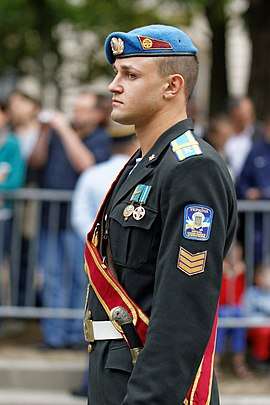
History
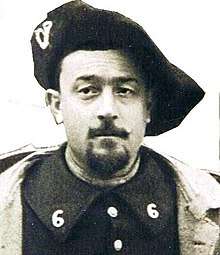
The use of beret-like headgear as a civilian headdress dates back hundreds of years, an early example being the Scottish Blue Bonnet, that became a de facto symbol of Scottish Jacobite forces in the 16th and 17th centuries. As an officially required military headdress, its use dates back to the Carlist Wars of Succession for the Spanish Crown in the 1830s by order of Carlist General Tomás de Zumalacárregui who wanted a local and non-costly way to make headgear that was resistant to the mountain weather, easy to care for and could be used on formal occasions.
The French Chasseurs alpins, created in the early 1880s, were the first regular unit to wear the military beret as a standard headgear.[1] These mountain troops were issued with a uniform which included several features which were innovative for the time, notably the large and floppy blue beret which they still retain.[2] This was so unfamiliar a fashion outside France that it had to be described in the Encyclopædia Britannica of 1911 as "a soft cap or tam o'shanter".[3]
Berets have features that make them attractive to the military: they are cheap, easy to make in large numbers, can be manufactured in a wide range of colors, can be rolled up and stuffed into a pocket or beneath the shirt epaulette without damage, and can be worn with headphones (this is one of the reasons why early tank crews adopted the beret). The beret is not so useful in field conditions for the modern infantryman, who requires protective helmets, and non-camouflage versions are seldom seen on operations.
The beret was found particularly useful as a uniform for armored-vehicle crews, and the British Tank Corps (later Royal Tank Corps) adopted the headdress as early as 1918.
German AFV crews in the late 1930s also adopted a beret with the addition of a padded crash helmet inside. The colour black was worn by the Royal Tank Corps later Royal Tank Regiment, since it did not show oil stains picked up inside the interior of a vehicle. Black berets continue to be worn by the Royal Tank Regiment, all other British armoured units wear blue berets, regiments in many armies also adopted the wearing of berets.
The wearing of berets of distinctive colors by elite special forces originated with the British Parachute Regiment, whose maroon beret was officially approved in July 1942,[4] followed by the Commando Forces whose green beret was approved in October of that year.[5] The United States Army Special Forces adopted a darker green beret in 1955, although it was not officially approved until 1961.[6]
Camouflage berets
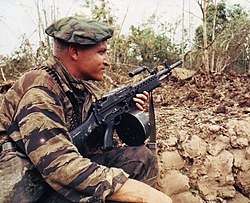
A camouflage beret is intended for use in the battlefield when wearing combat fatigues. They are mostly issued to the likes of special forces, particularly in jungle warfare operations.
History
_-_1946-03-12_-_Casarano.jpg)
Camouflage berets possibly originate from the General Service cap "Cap, General Service" issued to the British Army in a Khaki material before the introduction of Berets. It was first introduced under "Army Council Instruction 1407" of September 1943. This cap was designed to replace the "Field Service cap" or "FS Cap" that had been worn since the outbreak of war. These caps were issued in priority to units serving overseas. UK based units got theirs later on. It was at first unpopular due to its over large appearance. This cap was not a beret. It was made from several pieces of drab cloth material, whereas a beret was a one piece item. It was based on the Scottish balmoral bonnet in design. First issues were made from the same gaberdine cloth as the old "FS" cap. Badges worn on it were the conventional Officers bronze, and OR's badges in both plastic and metal. Units which had special distinctions could still wear these on the "GS" cap. The General Service cap was worn by regulation one inch above the eyebrows, with badge over the left eye and the cap pulled down to the right. But many wartime photos will show it worn pushed back on the head, which seemed to be a fashion with many soldiers late in the War.
Officers could only obtain the cap upon repayment to the RAOC. They were not allowed to buy the cap until their unit had been issued with it wholesale. Higher ranking Officers often got away with wearing a Khaki beret, which was against regulations. Fashion conscious OR's would also risk punishment from NCO's/officers buying one of these for "walking out".
Not exactly camouflage, but an early example is the Jungle Beret issued to the Australian Army during WW2.[7][8][9]
Users














By country
Afghanistan
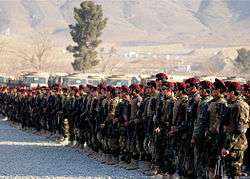
Most berets are used by senior enlisted personnel and officers.
| Colour | Wearer | |
|---|---|---|
| Forest Green | Afghan Armed Forces | |
| Maroon | Commandos | |
| Tan | Special Forces | |
| Cerulean | Afghan National Police | |
Algeria
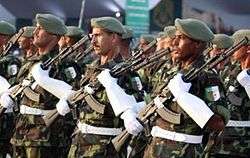
Light green berets are used by para-commando units.
Angola
In the Angola Armed Forces, the following berets are in use:
| Colour | Wearer | |
|---|---|---|
| Green | Páraquedistas (Paratroopers) | |
| Brown | Army general use | |
| Black | Navy and Fuzileiros Navais (Marines) | |
| Red | Commandos | |
| Medium blue | Air Force | |
Argentina
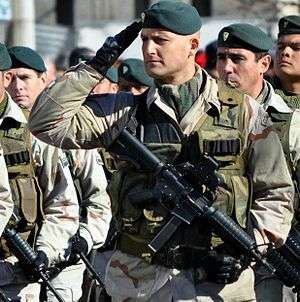
Berets are worn by some units in the Argentine Armed Forces,[11][12] with distinctive colors for some units or functions. The beret colours are as follows:
| Colour | Wearer | |
|---|---|---|
| Dark Green | Commandos | |
| Black | Armor & mechanized infantry troops | |
| Scarlet | Paratroops | |
| Claret | 601 Air Assault Regiment | |
| Tan | Mountain troops | |
| Dark Blue | Army aviation | |
| Brown | Amphibious engineers | |
| Olive green | All other army units | |
| Colour | Wearer | |
|---|---|---|
| Dark Green | Amphibious Commandos Group | |
| Black | Naval Infantry Command in the windy southern regions | |
| Brown | Navy Tactical Divers Group | |
| Colour | Wearer | |
|---|---|---|
| Dark Blue | Air Force Special Operations group | |
| Dark Green | Gendermarie | |
| Orange | Instituto Antártico Argentino | |
| UN blue | United Nations operations | |
Armenia
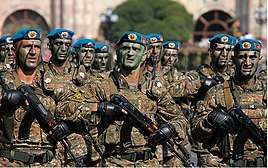
The Armed Forces continue to wear Soviet-style (pieced fabric) berets, which are draped to the right in most circumstances. When appearing in public on parade, the berets are draped to the left side so that the insignia shows to observing dignitaries and the public.
- Light blue - Airborne Forces, Peacekeeping Forces
- Black - Interior Ministry Troops
- Wine red - Interior Ministry Special Troops
- Bright Green - Border Guards
Australia
In all service branches, the beret is "bashed" to the right, and a badge or insignia is worn above the left eye. In the army, all units can wear them, with certain units wearing unique ones.[13] In the navy, the beret is an optional item,[14] and in the air force, it is only worn by certain units.[15]
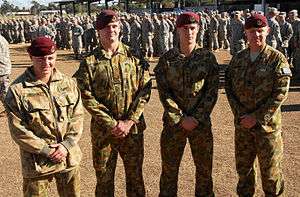
| Colour | Wearer | |
|---|---|---|
| Dark blue | All members of the army, who are not eligible to wear a specific one | |
| Black | Royal Australian Armoured Corps | |
| Rifle green | Royal Australian Regiment | |
| Light blue | Australian Army Aviation | |
| Scarlet | Royal Australian Corps of Military Police | |
| Dull cherry | Parachute qualified personnel posted to No. 176 Air Dispatch Squadron, Air Movements Training and Development Unit, Australian Defence Force Parachuting School and other parachute riggers | |
| Sherwood green | 1st Commando Regiment and 2nd Commando Regiment | |
| Fawn | Special Air Service Regiment | |
| Slate grey | Royal Australian Army Nursing Corps, unless posted to an armoured or aviation unit | |
| UN blue | Personnel serving with the United Nations | |
| Terracotta | Appointments to the Multinational Force and Observers | |
| Colour | Wearer | |
|---|---|---|
| Dark blue | No. 1 Security Forces Squadron RAAF, No. 2 Security Forces Squadron RAAF and No. 3 Security Forces Squadron RAAF personnel, with the exception of explosive ordnance disposal technicians[16] | |
| Aircraft grey | B Flight, No. 4 Squadron[15] | |
| Colour | Wearer | |
|---|---|---|
| Navy blue | Optional for all naval personnel | |
Austria
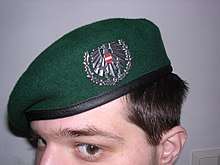
The Austrian coat of arms is worn on the left side of the beret (officers in gold, NCOs in silver, enlisted personnel as well as conscripts in dark grey). An exception to this rule are members of the Austrian special forces (Jagdkommando); after successfully completing the Basic Special Forces Course ("Jagdkommandogrundkurs"), they wear the Special Forces Badge ("Jagdkommandoabzeichen") instead of the Austrian coat of arms on their berets.
| Colour | Wearer | |
|---|---|---|
| Green | Infantry, various other units | |
| Black | Tank & armored infantry (Panzergrenadier) | |
| Scarlet | Guards Battalion (Gardebataillon) | |
| Maroon | 25th (Airborne) Infantry Battalion (Jägerbataillon 25) | |
| Coral | Military Police | |
| Auburn | 1st and 2nd Command Support Battalion, Command Support School | |
| Pike Grey | CBRN Defense School, Austrian Forces Disaster Relief Unit (AFDRU) | |
| Dark Blue | Logistic Command, Army Logistics School | |
| Yellow Green | Athletes and other members of Armed Forces Sports Centers | |
| Olive | Special Forces (Jagdkommando) | |
| Light Blue | Austrian military personnel serving in UN peacekeeping missions | |
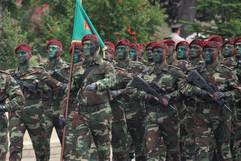
Azerbaijan
| Colour | Wearer | |
|---|---|---|
| Green | State Border Service (Azerbaijan) Mobile Divisions | |
| Black | Azerbaijani National Guard Mobile Divisions | |
| Red | Internal Troops of Azerbaijan, Special Forces of Azerbaijan | |
| Medium blue | Internal Troops of Azerbaijan Special Purpose Police Unit | |
Bahrain
- Black - Royal Bahraini Army and Royal Bahraini Naval Force
- Blue - Royal Bahraini Air Force
- Red - Military Police
- Tan - Special Forces
- Green - Royal Guard
- Olive Green - National Guard
- Maroon - Public Security Forces
- Dark Blue - Coast Guard
- Dark Green- Harasat
.jpg)
Bangladesh
- Black — Artillery, Armoured corps, Signals and all officers from and above the rank of Colonel
- Bangladesh Green — Infantry
- Dull Cherry — Army Medical corps
- Scarlet — Military police
- Maroon — Commandos
- Royal Blue — Engineers, Service corps
- Dark Blue — Education corps, Electrical and mechanical engineers, Ordnance, Artillery, Army Dental corps, Naval Service
- Any color with feathers-Cadet
- UN Blue — Personnel serving with the United Nations on international peacekeeping missions
Belgium

Initially, the only unit of the Belgian military to wear berets were the Chasseurs Ardennais from the 1930s. Since World War II they have been adopted by all units. Berets vary in colour according to the regiment, and carry a badge (sometimes on a coloured shield-shaped patch) which is of gilt for officers, silver for non-commissioned officers and bronze for other ranks. Members of cavalry units all wear silver coloured badges.
| Colour | Wearer | |
|---|---|---|
| Black | Armoured troops, Guides (Scouts), Chasseurs à Cheval and some engineer units | |
| Dark Green | Medical component | |
| Green | 2 Commando, Paracommando Field Artillery and the Commando Training Centre | |
| Olive Green | (Large-brimmed, basque type with folded-in brim and wild boar's head badge ) — Chasseurs Ardennais | |
| Dark Blue | Artillery and Royal Military Academy | |
| Navy Blue | (No metal cap badge, but embroidered crest) — Navy component (Formerly also naval infantry with metal badge) | |
| Cobalt Blue | Logistics and administration troops | |
| Blue Grey | Air component | |
| Light Blue | Former Land component Light Aviation (now part of Air Component) | |
| Maroon | Paracommando Immediate Reaction Cell (HQ), 1 Para, 3 Para, Special Forces Group, Parachute Training Centre | |
| Red | Military police | |
| Brown | Infantry, Chasseurs à Pieds and Belgian United Nations Command (during the Korean War) | |
| Khaki | "General service" beret with lion badge worn on training by all troops (Obsolete) | |
| Grey | Transmission troops and some engineer units | |
| UN Blue | Personnel serving with the United Nations on international peacekeeping missions | |
Benin
| Colour | Wearer | |
|---|---|---|
| Black | Armoured corps | |
| Green | Infantry and other Army units | |
| Dark Blue | Gendarmerie | |
| Maroon | Paratroopers | |
Bolivia
Berets in Bolivian Army:
- Black — Paratroopers
- Maroon — Armoured Corps
- Green — Special Operations Forces, Commandos
- Camouflage — Special Forces "Bolivian Condors"
- Tan — Mountain Infantry (Satinadores de Montaña)[17]
- Blue — Engineer units
Berets in Bolivian Air Force:
- Royal Blue - Air Force Infantry personnel
Brazil
.jpg)
| Colour | Wearer | |
|---|---|---|
| Olive green | All other Army units | |
| Brown | Were used by Units of the COPESP (As of 2016 is being replaced by Wine Red Berets, For who is a Paratrooper, or Olive Green Barets and Black Caps) | |
| Black | Used by Armored and Mechanized Cavalry/Infantry Brigades. | |
| Scarlet red | Students of Colégio Militar (middle and high school). | |
| Grey | Mountain Units, From the 4° Light Infantry Brigade | |
| Dark blue | Students of Military Formation Schools (Cadets, Officer Candidates, NCO Candidates) | |
| Royal blue | Army aviation, From the CAvEx. | |
| Wine red | Paratroopers | |
| Camouflage | Jungle troops (stopped being used in 2012 and will resume usage in early 2017) | |
| Tan | Air Assault Units (From the 12° Light Infantry Brigade) | |
| UN blue | Personnel serving with the United Nations on international peacekeeping missions | |
Bulgaria
Berets have been worn by Bulgarian military personnel since 1991. Berets vary in colour according to the military branch, and carry a crest pin (sometimes on a coloured background patch) resembling the unit's insignia.
- Red — Bulgarian Land Forces and the counter-terrorism police detachment SOBT
- Light blue — Bulgarian Air Force and the 68th Special Forces Brigade
- Black — Bulgarian Navy SOF and the Gendarmerie
- Green — Military police

Cambodia
- Dark red - 911 Special Forces Regiment
- Royal Purple - Military Police
Cameroon
- Bataillon des Troupes Aéroportées (Airborne Battalion) - dark red/maroon
- Bataillon Spécial Amphibie (Special Amphibious Battalion) - Dark green
- Bataillon d'Intervention Rapide (Rapid Intervention Battalion) - light green
- Fusiliers de l'Air (Air Force Infantry) - royal blue
- Fusiliers Marins (Marine Infantry) - black
- Garde Presidentielle (Presidential Guard) - royal purple
- " All others army units - Navy Blue
- " Gendarmerie (military Police) - Red
Canada
- Main article Uniforms of the Canadian Armed Forces#Berets
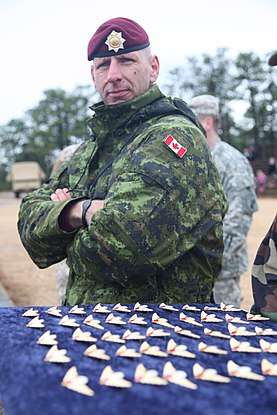 A jumpmaster from Canada stands next to a tray of Canadian jump wings before he presents them to U.S. Army paratroopers during the 16th Annual Randy Oler Operation Toy Drop, Dec. 7, 2013, at Sicily Drop Zone, Fort Bragg, N.C. Operation Toy Drop is the largest combined airborne operation in the world, with nine allied nations participating. These Canadian jump wings were earned after jumping under the command of a Canadian jumpmaster. (U.S. Army photo by Sgt. Austin Berner/Released)
A jumpmaster from Canada stands next to a tray of Canadian jump wings before he presents them to U.S. Army paratroopers during the 16th Annual Randy Oler Operation Toy Drop, Dec. 7, 2013, at Sicily Drop Zone, Fort Bragg, N.C. Operation Toy Drop is the largest combined airborne operation in the world, with nine allied nations participating. These Canadian jump wings were earned after jumping under the command of a Canadian jumpmaster. (U.S. Army photo by Sgt. Austin Berner/Released)
The colour of the beret is determined by the wearer's environment, branch, or mission. The beret colours listed below are the current standard:
| Colour | Wearer | |
|---|---|---|
| Air force blue | Air force | |
| Black | Navy, Royal Canadian Armoured Corps | |
| CF Green | Army | |
| Scarlet | Military police | |
| Maroon | Paratroopers serving in active jump companies | |
| Blaze orange | Search-and-rescue technicians | |
| Terracotta | Personnel serving with the Multinational Force and Observers | |
| Tan | Special operations forces | |
| UN Blue | Personnel serving with the United Nations on international peacekeeping missions | |
| Dark blue | Royal Regiment of Canadian Artillery, Royal Canadian Electrical and Mechanical Engineers, Royal Canadian Corps of Signals, Canadian Intelligence Corps[18] | |
| Khaki | Foot guard regiments[18] | |
Chile

Berets in Chilean Army:
- Black — Special Operations Brigade "Lautaro" (Commandos, Paratroopers and Special Combatants)
- Maroon — Armoured Cavalry
- Green — Mountain troops
- Olive green — Aviation Brigade
Berets in Chilean Navy:
- Black — Combat crews and Maritime Boarding and Police operatives
- Green — Combat Divers (Navy) and Marine special forces
Berets in Chilean Air Force:
- Dark blue — Parachuting demonstration group Boinas Azules and Ground troops
- Black — Special forces
China
Since May 5, 2000, the People's Liberation Army has adopted woolen berets for all its personnel,[19] along with the traditional peaked caps. Type 99 beret
- Olive green — Ground Forces and Strategic Forces
- Dark blue — Navy
- Black - Marine corps
- Blue-grey — Air Force (including Airborne troops)
Berets were not officially adopted by the CAPF, but some of the forces issued their own types NOT OFFICIAL:
- Red—CAPF Provincial Women Special Police Corps
- Dark blue—Public Security Police SWAT
During the 80s, camo berets were issued to some of the recon forces of PLA. It has no badge on it.
Type 07 uniform is being issued to both PLA and CAPF on August 1, 2007. Colours of 07 berets are changed to the same colours with the service uniform. And several changes in designs were made from type 99 beret. The berets were not being issued until summer of 2009 to most of the troops.
Other than colours of the berets, the most significant difference between type 99 and type 07 is the type 99 beret badge is cloth, while type 07 is plastic.
Colombia

Berets are worn by all personnel of the National Army of Colombia (Ejército), certain members of the Navy (Armada) and National Police (Policía Nacional), with distinctive colors for some units or functions. The beret colors are:
| Colour | Wearer in Army | Wearer in Navy | Wearer in Police | |
|---|---|---|---|---|
| Black | Lancero, Personal Freedom Unified Action Group (GAULA), Lanceros School | Naval Infantry | Special Operations Commands (COPES) | |
| Hunter Green | Ground Operations Units | Special Operations Groups(GOES) | ||
| Orange | Infantry battalion (COLBATT) in Multinational Force and Observers (MTO) | |||
| Prussian Blue | Aerotransported units and Paratroopers School | |||
| Red Wine | Urban Special Forces | |||
| Terracotta | Special Forces | |||
| UN Blue | Personnel serving with the United Nations on international peacekeeping missions | |||
Croatia
In the Croatian Army berets are used in special forces and guard brigades, as well as in cadet battalion.
During Croatian War of Independence, Croatian Army consisted of seven professional brigades—guard brigades, each having its beret colour. During the army reforms number of guard brigades was cut to two, but the battalions kept the names and insignia (colour of beret also) of ex brigades.
Joint staff:
- Green with golden cap badge — Joint staff
- Red — presidential guard on their battledress uniforms
- Green (badge on the right) — Special Operations Battalion
- Black — Military police
Guard brigades:
- Armored Mechanized Guard Brigade
- Black — 1st Mechanized Battalion "Sokolovi"
- Brown — 2nd Mechanized Battalion "Pume"
- Black — Tank Battalion "Kune"
- Motorized Guard Brigade
- Black — 1st Mechanized Battalion "Tigrovi"
- Green — 2nd Mechanized Battalion "Gromovi"
- Black — 1st Motorized Battalion "Vukovi"
- Red — 2nd Motorized Battalion "Pauci"
Black beret is also used in Cadet battalion. Also dark blue beret is used in Croatian Navy.
Cuba
In the Cuban Revolutionary Armed Forces, the following berets are in use:
| Colour | Wearer | |
|---|---|---|
| Black | Tank troops (tanquistas) wear black berets (including the "Gran Unidad Rescate de Sanguily"); also the special troops (Brigada Especial Nacional "Gallitos Negros") of the interior ministry (MININT).[20][21][22] | |
| Red | The military police (Tropas de Prevención) wear red berets.[23][24][20][22] | |
| Olive Green | Special forces (Tropas Especiales "Avispas Negras") since 2011, wear olive green berets (formerly wearing red berets).[20][21][22] | |
| Olive | Militias (Milicias de Tropas Territoriales) wear olive-colored berets [20][25][21] | |
Czech Republic
The Armed Forces of the Czech Republic use berets for both battledress and display uniform. The colour of the beret is defined by the branch of the armed forces. The beret displays the state coat of arms with two swords crossed underneath and the badge of rank of the individual.[26]
| Colour | Wearer | |
|---|---|---|
| Black | Military Police | |
| Dark Green | Reconnaissance troops | |
| Dark Blue | Air Force | |
| Maroon | 4th Rapid Deployment Brigade, 601st Special Forces Group | |
| Orange | Paramedics | |
| Grey | Logistics | |
| Light Green | Other ground forces (mechanised infantry, armour, artillery, NBC protection, Engineering Brigades, etc.) | |
Denmark
The Royal Danish Army first introduced berets for its armour personnel in 1958.[27] It was later extended to the whole army, Homeguard and parts of the Navy and Airforce, replacing the standard issue Side cap.[28]
| Colour | Wearer | |
|---|---|---|
| Black | All Army combat units: SLFR, JDR, GHR, LG,Garnisonskommandant Vordingborg and DAR[29] | |
| Green | All Army non-combat units: Engineers, Logistics, Army Intelligence Center, Army Home Guard | |
| Dark Blue | Royal Danish Navy; Naval Home Guard; Signal troops | |
| Light Blue Grey | Royal Danish Air Force; Air Force Home Guard | |
| Maroon | Jægerkorpset, SOKOM | |
| Red | Military Police (All Branches) | |
| Light Blue (or "Mouse Grey") | Army Air Service, Disbanded | |
| Dark brown | Danish Women's Voluntarily Corp (Danish: Dansk Lottekorps), Disbanded | |
| Blue | Signal troops Color Disbanded | |
| UN Blue | Personnel serving with the United Nations on international peacekeeping missions | |
.jpg)
Ecuador
Berets are worn by all personnel of the Ecuadorian Army (Ejército) and certain members of the Navy (Armada) and Air Force (Fuerza Aérea), with distinctive colours for some units or functions. The beret colours are:
| Colour | Wearer | |
|---|---|---|
| Black | Military Police; Naval Infantry (Infantería de Marina) | |
| Dark Green | all other Army units; National Police GIR (Intervention & Rescue Unit) | |
| Dark Blue | Army Aviation (Aviación del Ejército); Air Force Aerial Infantry (Infantería Aérea) | |
| Royal blue | Air Force Security Police | |
| Red | Paratroopers and Special Operations Forces | |
| Grey | for use with the dress uniform (4-B) for those forces using the dark green beret | |
| Camouflage | IWIA (indigenous tribal members unit) forces | |
Egypt
- Maroon — Paratroopers
- Forest green — Armour
- Dark blue — Infantry
- Dark blue with red band — Presidential Guard
- Black — Artillery
- Red — Military Police
- Green — Engineers
Eritrea
All personnel of the EDF or Eritrean Defense Forces wear Berets.
- Red — Air Force Units
- Green — Army Units
- Blue — Naval Units
- Purple — Border Guard
Estonia
All personnel in the Estonian Military used to wear Berets in the beginning on 90's. In 2013, berets were reinstated.
- Green — Ground Forces
- Black — Armoured Corps, Naval Units
- Red — Military police
- White - Military Bands Service when not in parade dress uniform
Finland
The Finnish Defence Force uses berets with cap badges for the Army, Navy and the Air Force. The berets are worn in "clean" garrison duties such as roll calls and with the walking-out uniform, but not with the battle dress. Until the mid-1990s, the beret was reserved for troops with special status, such as the armoured troops, coastal jägers and the airborne jägers, but is nowadays used by all units. In the winter, berets are replaced by winter headgear.
Berets are also used by the Finnish Border Guard, which is a military organization under the aegis of Ministry of Interior during peacetime.
- Brown (Badge: golden bear's head, sword and fir tree twig) — Special Border Jägers
- Olive (Badge: golden bear's head, sword and fir tree twig) — Border Jägers
- Olive (Badge: silver lion's head) — Army
- Olive (Badge: golden lion's head with crown) — Finnish Rapid Deployment Force and Army units abroad (other than UN peace keepers)
- UN Blue (Badge: UN white and blue embroidered patch) — UN peace keepers
- Black (Badge: silver Gothic helmet) — Armoured Brigade
- Burgundy (Badge: arrow and parachute) — Airborne Jägers of the Utti Jäger Regiment
- Royal Blue (Badge: silver griffin) — Army helicopter pilots
- Royal Blue (Badge: silver Air Force insignia) — Air Force
- Royal Blue (Badge: golden harp with sword) — Military bands
- Navy Blue (Badge: silver anchor and golden lion) — Navy, including coastal troops, except for Coastal Jägers
- Green (Badge: gold sea eagle's head) — Coastal Jägers
France

The military beret originated in the French Army, in the form of the wide and floppy headdress worn by the Chasseurs Alpins (mountain light infantry) from their foundation in the early 1880s.[30] The practical uses of the beret were soon recognised and the Marine Infantry forming part of the Expeditionary Force sent in China in 1900 used berets as headwear[31] A tight-fitting version was subsequently adopted by French armoured troops towards the end of World War I. Between the wars, special fortress units raised to garrison the Maginot Line wore khaki berets as did the 13th Demi-Brigade of Foreign Legion when it was created in 1940. The Vichy Milice of the War period wore a blue beret.
The beret in blue, red or green was a distinction respectively of the Metropolitan, Colonial and Foreign Legion paratroop units during the Indochina and Algerian wars. In 1962 the beret in either light khaki or the colours specified above became the standard French Army headdress for ordinary use.[32]
With the exception of the Commandos Marine and the Fusiliers Marins, whose berets are worn pulled to the right, all other French military berets (army, air force and Gendarmerie) are pulled to the left with the badge worn over the right eye or temple. Gendarmerie personnel serving with the European Gendarmerie Force (EUROGENDFOR) – an EU crisis response and intervention force – wear the standard EUROGENDFOR royal blue beret and badge when so assigned.
| Colour | Wearer | |
|---|---|---|
| Wide beret, dark blue | Chasseurs Alpins (the wide beret's nickname is the tarte (pie) also worn with a white cover (winter dress)). | |
| Dark blue | Fusiliers Commandos de l'Air; Troupes de Marine and all other army troops; Gendarmerie; Fusiliers Marins (pulled to the right) | |
| Green | French Foreign Legion | |
| Dark Green | Commandos Marine (pulled to the right) | |
| Red (called amarante) | Paratroopers (except paratroopers of the Foreign Legion who wear Legion green) | |
| Azure blue | French Army Light Aviation | |
| Black | Armoured regiments (régiments de chars de combat) | |
| UN blue | Personnel serving with the United Nations on international peacekeeping missions | |
Gabon
Berets in Gabonese Army:
- Dark red/rouge— Paratroopers
- Light grey — Armoured troops
- Green — Republican Guard
- Green — Commandos Marine
- Dark red — Army Medical Corps
- Dark blue — other Army units
Germany

The German Heer uses berets with different badges for every branch of service. The Luftwaffe and the Marine issue dark blue berets only to their ground or land combat units (called Luftwaffensicherungstruppe and Marineschutzkräfte) respectively. Berets are usually worn at special ceremonies and roll calls, although units with a special esprit de corps, especially armoured and mechanized infantry (Panzergrenadiere) battalions, wear their berets all the time. German berets are always pulled to the right, with the badge visible over the left temple.
| Colour | Wearer | |
|---|---|---|
| Black | armoured units, including armoured reconnaissance | |
| Green | infantry units, including Jägertruppe (light infantry), Panzergrenadiere (armoured infantry), army ceremonial guards (Wachbataillon des Heeres) and the now disbanded Panzerjäger (armoured anti-tank); | |
| Dark blue | Luftwaffe (Air Force) and Marine (Navy) infantry and Combat Divers, ceremonial guards; Offizieranwärterbataillon (Officer Candidate Battalions of the Army) multinational units (e.g. Eurocorps) CYBER Technology Units (CIR) | |
| Blue | medical units | |
| Maroon | airborne units (or units with substantial airborne components), including paratroopers, army aviation, Airmobile Operations Division (DLO; Division Luftbewegliche Operationen), and Division Special Forces (DSK; Division Spezielle Kräfte), including the KSK (Kommando Spezialkräfte) | |
| Red | support units, including artillery, engineers, intelligence, psychological operations (Operative Information), anti-aircraft, supply, NBC protection, signals, electronic warfare, transport, topography, and military police (Feldjäger), 'Instandssetzung' Vehicle Maintenance | |
| UN Blue | Personnel serving with the United Nations on international peacekeeping missions | |
Military bands wear the beret colour of their respective division (e.g. black in the 1. Panzerdivision).
Note: The Panzerjäger started off with black berets but were moved into the Panzergrenadier branch. The last Panzerjägers wore green berets.
Ghana
The beret colours worn by the Ghana Army are as follows:
- Black — Armoured Corps
- Dark Green — Airborne Force (ABF)
- Red — Military Police
- Dark Blue — All other Arms and Corps
Greece
The beret colours worn by the Hellenic Army are as follows:
- Light blue — Presidential Guard
- Black — Armoured Corps
- Green — Special Forces (including Commandos, Marines and Parachute despatchers/riggers)
- Dark red/maroon — Army Aviation
- Bright red/scarlet — Airmobile troops
- Dark Blue — All other Arms and Corps when in 8a, 8b and 8c Service Dress.
- Red -71st Airmobile Brigade (PONDUS)
When in camouflage fatigues, the camouflaged cap is worn instead of the dark blue beret. The beret colours worn by the Hellenic Air Force are:
- Blue-grey (same colours as RAF) — Air Force Underwater Operations Squadron
- Dark red/Maroon — Air Force Special Operations Squadron

Hungary
History: the first beret-type cap (khaki colour, with black ribbon and "eagle" badge) was issued for Air Force enlisted personnel in 1930, but berets became popular in the 1970s, when reconnaissance troops (paratroopers) were issued with rifle green (or grass green) berets. Previously maroon beret was also experimented and even reversible (green to camo) "multi-purpose" berets were produced, but the standardization started on the 1975 military parade. In 1982 military secondary school students were issued with green berets too, while in 1987 River Force troopers received dark blue beret. After the collapse of the communism the beret as "mark of the elite trooper" received more and more popularity among soldiers.
Berets currently in Hungarian military:
- Black (with tank troops' badge) — Armoured Units
- Black (with oak leaf badge) — Voluntary Aera Defend Reservist's
- Black (with anchor badge) — Flotilla
- Red (with MP badge) — Military Police
- Scarlet (with artillery or AA badge) — Artillery, Anti-Aircraft Artillery
- Dark green (with paratroops badge) — Paratroopers, Long-range recons, Field recons
- Olive green (with engineer's badge) — Engineers (only in foregin missions)
- Olive green (with infantry badge) — Infantry (only in foreign missions)
- Grass green (with border guard's badge)- Border Guard (only 1990-2007)
- Dark brown (with infantry badge) — Guard Battalion Special Team (only in the 2000s)
- Tan (with special operation's badge) — 2nd Vitéz Bertalan Árpád Special Operations Brigade
Except these official versions different unofficial beret types, colours and badges are worn, for example Dark Blue berets by Signal Corps cadets etc.
Iceland
Icelandic armed services commonly use berets.
| Colour | Wearer | |
|---|---|---|
| Black | Icelandic Coast Guard | |
| Dark Blue | Icelandic Crisis Response Unit | |
India
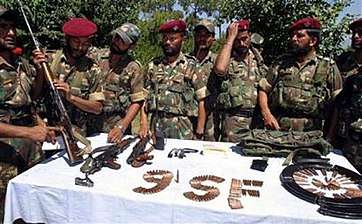
The beret is the standard headgear for the Indian Army. Berets are worn by officers and other ranks, apart from Sikhs, who wear turbans. The beret colours worn by the Indian Army are as follows:
- Light Green (shades vary considerably) — Infantry regiments and Military Intelligence
- Dark (rifle) green — Rifle Regiments, some Light Infantry regiments (including the Mechanised Infantry Regiment), COBRA jungle warfare Commandos, and the National Cadet Corps
- Maroon — The Parachute Regiment, Special Forces, Special Frontier Force, Garud Commandos and Marine Commandos
- Black — Armoured Corps, Border Security Force (BSF), the National Security Guards (NSG)
- Grey — Army Aviation Corps, IMA & OTA Cadets and the Indian Air Force [NC(e)]
- Scarlet — Corps of Military Police
- Navy blue — The Regiment of Artillery, Corps of Engineers, Corps of Signals, Support Arms and Services, Indian Navy, Indian Coast Guard, the Indo-Tibetan Border Police Force
- Sand — Border Road Organisation and General Reserve Engineer Force
- Dark Blue — National Disaster Response Force
- Light Blue — All personnel serving with the United Nations forces irrespective of unit, arm or service
Indonesia

The beret is the standard headgear of armed forces and police personnel in Indonesia. It is also worn by paramilitary and other uniformed services in the country such as the Fire Brigade, Search and Rescue, Scouts, civil militias (such as Banser) and civil paramilitary organizations. In the Military Services (Army, Navy and Air Force), the berets are dragged to the right (the insignia are worn on the left side), while in the Indonesian National Police force and Military Police Corps, the berets are dragged to the left (the insignia are worn on the right side). Both having its own meaning, dragged to the right meaning "ready for combat and defense" and dragged to the left meaning "ready for law enforcement and order". Military and Police services according to their beret colours which represent different units within the force are as shown below:
- Indonesian Army (TNI AD) [33]
- Green - Army HQ, Territorial Army, regular Infantry and Army staff
- Red - Army Special Forces Commandos ("Kopassus") including Para-Commandos
- Dark Green - Raider Infantry air-mobile and special operations capable units, Mechanized Infantry and the Strategic Command Corps ("Kostrad") which itself includes infantry brigades, Airborne brigades, reconnaissance platoons, cavalry and artillery battalions.
- Black - Cavalry and Armored Cavalry (Tank) Corps
- Brown - Field Artillery corps and Air Defense Artillery corps
- Steel Gray - Corps of Engineers (currently changed to green)
- Maroon - Army Aviation Corps
- Khaki - Signal Corps
- Dark Blue - Logistics and Transportation Corps
- Indonesian Navy (TNI AL)
 Paskhas commandos in formation wearing their distinctive orange beret
Paskhas commandos in formation wearing their distinctive orange beret- Navy Blue - Standard berets for the Navy, worn by all personnel such as Naval seamen and naval sailors in duty of ships' company, or on the Naval bases.
- Reddish Purple (Magenta) - Marine Corps and Joint naval special forces (Jala Mengkara Detachment)
- Maroon - Frogman Command
- Indonesian Air Force (TNI AU)

- Blue - Standard berets for the Air Force, with Air Force insignia worn by Airmen and Air Force staff.
- Orange - Air Force Infantry Special Operation Corps (Korps PasKhas).
- Inter-services
- Black - All personnel in Armed Forces/TNI HQ
- Light Blue (beret dragged to the left) - Military Police personnel from all branches.
- Light Blue - All personnel attached in United Nations' Peace Keeping Force, and the Presidential Security Force (Paspampres)
- Dark Brown - Military Cadets
- Paramilitary units (not part of armed forces/TNI)
- Dark Blue - Mobile Brigade Corps (Brimob), beret dragged to the left
- Non-military
- Dark Brown - Scouts
- Light Brown - Ministry of Defence employees and Armed Forces Civil Servants (PNS), beret dragged to the left
- Purple - College Students Regiment
Iran
.jpg)
- Dark Blue - Iranian Marines
- Black - Iranian Army Airborne Forces, IRGC Commandos, and Police
- Green - Iranian Army Special Forces (Rangers), Iranian Marines Special Forces, IRGC Special Forces
- Tan - Iranian Army Commandos
- Maroon - Iranian Army Tank Crew
Iraq

The beret color system used for the different branches of the Iraqi military and security forces changed after the fall of Saddam Hussein. Beret colors currently (and formerly) worn by Iraqi forces are as follows:
- Maroon — Army (formerly Special Republican Guards, Paratroops and/or Special Forces)
- Khaki (olive green) — no longer used (formerly Logistics and Transport personnel)
- Green — Special Forces (formerly Commandos and Thunder Paratroops)
- Bright Red — Military Police
- Black — Police (formerly Republican Guards and regular Army)
- Blue — Air Force
- Dark Blue - Iraqi Navy
- Blue-Grey - no longer worn (formerly Iraqi Air Force)
Ireland

All Army personnel wear a common capbadge, a sunburst insignia with the letters "FF" inscribed above the left eye of the beret. The Irish Defence Forces cap badge for Officers in the Army has a more subdued appearance. Air Corps and Naval Service personnel wear their own cap badge on berets.
The beret colours worn by the Irish Defence Forces are as follows:
| Colour | Wearer | |
|---|---|---|
| Black | Army, Air Corps and Naval Service - Army personnel wear red patch behind cap badge | |
| Red | Military Police | |
| Dark green | Army Ranger Wing (special forces) | |
| UN blue | Personnel serving with the United Nations on international peacekeeping missions | |
The beret colours worn by the Reserve Defence Forces are as follows:
| Colour | Wearer | |
|---|---|---|
| Black | Army Reserve - worn with red patch behind cap badge | |
| Red | Reserve Military Police - worn with dark green patch behind cap badge | |
| Black | Naval Service Reserve | |
Israel

Israeli Defense Forces soldiers wear berets only on formal occasions, such as ceremonies and roll calls, and in disciplinary situations such as courts martial and imprisonments. While they are not attending formal occasions, they must place the beret beneath the left epaulette. The Border Police, which are a unit of the civil police rather than the military IDF, wear their berets at most times. The beret colors are as follows:
| Colour | Wearer | |
|---|---|---|
| Black | Armor Corps | |
| Light Brown | Golani Brigade | |
| Dark Gray | Air Force | |
| Maroon | Paratroopers Brigade and SF units | |
| Lime Green | Nahal Brigade | |
| Purple | Givati Brigade | |
| Camouflage | Kfir Brigade | |
| Desert Camouflage | Combat Intelligence Corps (current) | |
| Khaki | Combat Intelligence Corps (in past) | |
| Turquoise | Artillery Corps | |
| Cyber blue | Computer Service Directorate | |
| Light Grey/ silver | Engineering Corps | |
| Bottle Green | Directorate of Military Intelligence, Border Police | |
| Blue | Military Police | |
| Orange | Home Front Command | |
| Olive Green | General Corps | |
| Dark Blue | Navy | |
Italy
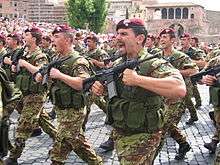

Italian Army personnel used to wear a garrison cap alongside the combination cap, until the early 1970s when the garrison cap was replaced by the beret. Until the early 1980s the general Army colour for the beret was drab khaki, the black being reserved to armoured units. The colours presently used by the Italian Army are as follows:
- Maroon — Paratroopers, Folgore Airborne Brigade; Army Incursori Special Operations Forces
- Light blue — Army Aviation, 66th Airmobile Infantry Regiment
- Black — all other Army units (the Bersaglieri light infantry have royal blue beret strings, instead of black ones like the rest of the Italian Military)
- Green - The Lagunari Serenissima amphibious infantry Regiment received 'Lagoon green' berets in 2011 after service in Afghanistan
The Italian Navy uses the following berets:
- Green — Navy Commando frogmen Operational Raider Group (COMSUBIN GOI)
- Medium blue - Navy Rescue frogmen Operational Divers Group (COMSUBIN GOS)
- Navy blue - San Marco Marine Brigade of the Italian Navy
- Orange - Units part of the Multinational Force and Observers mission in Sinai
The Italian Air Force uses the following berets:
- Teal blue — Air Force guards
- Tan — Air Force Incursori (RIAM)
Other Italian services that use berets:
- Maroon — Carabinieri Tuscania Airborne Regiment; Police di Stato Parachute units (Display Team and NOCS)
- Green — Guardia di Finanza (GICO); Corpo Forestale dello Stato
- Light blue — Prison Police
- Dark blue - Carabinieri (MP units)
- Red — Carabinieri Cacciatori Hunter units
- Grey — Guardia di Finanza
- Blue — Polizia di Stato
Japan
All members in the Ground Self-Defense Force are authorized to wear wool rifle green berets - referred to as the "ベレー帽" (ベレーボウ or bereebou) - as an optional head covering for dress, working and camouflage uniforms since 1992. However, it is normally considered a special dress item, worn for public relations events or parades. An embroidered goldwork cap badge representing the JGSDF logo identical to the one used on the service dress peaked cap is required by regulation to be affixed to the beret.
Jordan
The beret colours worn by the Jordanian Army are as follows:
- Brown - Infantry
- Maroon — Special Forces
- Black — Armoured Corps
- Green — Royal Guards
- Dark Blue - Artillery
- Sky-blue - Engineers
- Red — Military police
- Grey Blue - Air Force
- Dark Blue - Navy
Kazakhstan
- Light Blue - Paratroops
- Maroon - National Guard - Internal security
- Orange - Emergency Rescue Units
- Navy Blue - Navy Units
Kenya
The beret colours worn by the Kenya Armed Forces are as follows:
- Black — Armoured Corps
- Green — Airborne Battalion
- Red — Military police
- Dark Blue - All other Arms and Corps including naval service
- Blue Grey - Air Force
Kuwait
- Green — National Guard
- Commando Green - 25th Commando Brigade
- Black — Army Ground forces and Navy forces
- Red — Military Police
- Maroon — Amiri Guard Authority
- Light Blue - Air Force
Latvia
The beret colours worn by the Latvian Army are as follows:
- Olive-green — Special Tasks Unit
- Red — Military police
- Black - National Guard, Navy
- Tan - Mechanized infantry brigade (army) from 18.11.2018
- Blue - Air Force
Lebanon
All units, in the Lebanese Armed Forces wear berets when not in combat mode (Helmet), training camp (cap) or formal uniform (formal hat).
The Lebanese Army, unlike most militaries, wears the beret slanted (pulled down) on the left side as the Army emblem is positioned to the right aligned with the right eyebrow.
- Green - The Fast Intervention Regiments (SF)(6 Regiments)
- Brown - Airborne Regiment (SF)
- Red - Military Police
- Black - Republican Guard Brigade (Presidential Guard), Anti-terrorism Unit MOKAFAHA (SF)
- Maroon beret - Commando Regiment Fawj al-Maghaweer (SF), Lebanese navy seals Maghāwīr al Baħr (SF)
- Dark Blue — The 11 Brigades, Cadets and the rest of the Army.
Lithuania
- Maroon — National Defence Volunteer Forces
- Scarlet — Military Police
- Green — All other forces excluding the Air Force and the Navy
- Grey — (SOP- Specialiųjų operacijų pajėgos) SOF- Special operations force
Malaysia
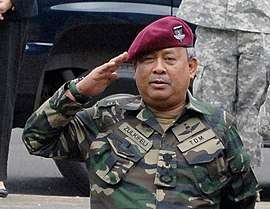
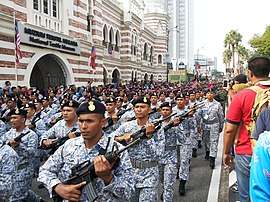

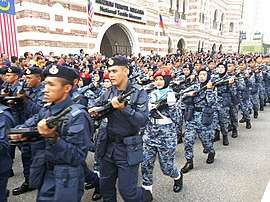
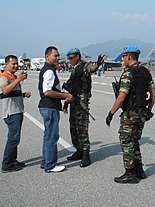
The beret is the headgear of ground forces, air aviations and special forces in the Malaysian Armed Forces. The colours presently used are:
| Colour | Wearer | |
|---|---|---|
| Black | Royal Armoured Corps | |
| Rifle Green | Royal Malay Regiment, Royal Ranger Regiment, Border Regiment | |
| Commando Green | Grup Gerak Khas (Army Special Forces) | |
| Cypress Green | Royal Intelligence Corps | |
| Cambridge Blue | Army Air Corps | |
| Maroon | 10 Parachute Brigade | |
| Scarlet | Royal Military Police Corps | |
| Dark Blue | other Army branches | |
| Colour | Wearer | |
|---|---|---|
| Dark Blue | Regular and reserve force personnel | |
| Magenta | PASKAL (Navy Special Forces) | |
| Colour | Wearer | |
|---|---|---|
| Dark Blue | Regular, reserve force and RMAF Provosts personnels | |
| Sky Blue | PASKAU (Air Force Special Forces) | |
| Red | Close Escort Team (VIP Protection) | |
Maldives
The beret colours worn by the Maldives National Defense Force (MNDF) are as follows:
- Maroon — Special Forces
- Red — Military Police
- Green — Marines and other support units
- Black — Parade Beret for Coast Guard
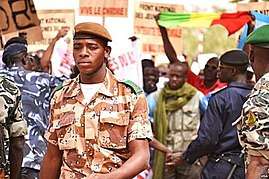
Mali
The beret colours worn by the Malian Armed Forces are as follows:
- Red — Paratroopers.
- Brown — National Guard.
- Green — Infantry and other army units.
- Dark blue — Air Force
- Blue - Police
.jpg)
Mexico
In the Mexican Army, the beret is worn by:
- Green - Special Forces
- Maroon — Paratroopers (formerly purple, circa 1980s)
- Black — Presidential Guards Corps
- Steel Grey — Armor
- Brown - Airmobile Units
In the Mexican Navy:
- Black — Paratroopers, Navy Special Forces.
Armed Forces wide, the blue beret with the UN arms is used by peacekeeping forces beginning in 2015–16, when Mexico sent armed forces personnel to UN peacekeeping operations.
Mongolia

In 2002, new army uniforms were introduced to the Mongolian armed forces and along with new uniform design, dark green berets were issued to all personnel. According to the rules, all military berets are pushed to the right and displays a "Soyombo" symbol in middle of golden oak leaves in the right side.
Berets are worn by Mongolian Police since 1994. Police berets are different from the army beret in color and in shape, while it is pushed to the left while army berets are pushed to the right.
- Dark green - All branches of Armed forces
- Red - Internal troops.
- Dark blue - National emergency troops (rescuers)
- Black - Police unit (pushed to the left)
- Light blue - UN peacekeepers (pushed to the right)
Morocco
The Moroccan military Uniform is inspired from the French Uniform, the berets are usually pulled to the left with the badge worn over the right eye or temple.
- Lime Green - Armed Forces (Les Forces armees royales), including Paratroopers
- Red - Royal Guard (La garde royale)
- Blue - Royal Moroccan air force
- Dark BLue - The Air Force and Security Forces
- UN Blue - Moroccan-United Nations troops Personnel serving with the United Nations on international peacekeeping missions
- Brown - Moroccan Auxiliary troops
Mozambique
.jpg)
Presently, the following berets are in use by the Defense Armed Forces of Mozambique:
- Brown — Army general use
- Red — Commandos
- Olive Green - Forcas Especiais (Special Forces)
- Navy blue — Fuzileiros (Marines)

Netherlands
.jpg)

When the Royal Netherlands Armed Forces acquired new modernised uniforms (designed by the Dutch couturier Frans Molenaar) in 2000, the berets changed as well. Since 2004, soldiers of the Royal Netherlands Army have worn a petrol (blue-green) beret, whereas previously they wore brown.
The following colours are also used (before and after the modernisation):
Navy:
- Dark navy blue with a bronze metal crown & anchor on a red flash — Royal Netherlands Marine Corps
- Dark navy blue with a gold color metal anchor on a black flash — Royal Netherlands Navy
- Dark navy blue with a silver color metal anchor on a Blue flash — (Civilian base security for the Royal Netherlands Navy)
Army:
- Green (The Green Beret) — Commandos of the Korps Commandotroepen
- Maroon (The Red Beret) — Airmobile troops of the 11 Air Manoeuvre Brigade "11 Luchtmobiele Brigade" (Air Assault)
- Black — Armour and Cavalry
- Petrol (blue-green) — Royal Netherlands Army
Note: The only Dutch military unit that do not wear a beret are the Gele Rijders (Horse Artillery), who wear a blue garrison cap with yellow trimming. Air Force:
- Grey-blue — Royal Netherlands Air Force
Military Police:
- Bright blue — with emblem Koninklijke Marechaussee (Royal Gendarmerie)
Other:
- UN blue — All military members of the United Nations
- Brick red — All military members of the Multinational Force and Observers
- Dark blue — 1(GE/NL)Corps (Eerste Duits-Nederlandse Legerkorps)
All regiments and services have their own distinctive colours. There are quite a lot, but the number of colours in the logistic services was reduced in 2001. This colour is shown in a patch of cloth behind the beret flash. The intendance (maroon), transport troops (blue), military administration (pink; hence the nickname 'Pink Mafia'), technical service (black), and medical troops and service (green) lost their colours and all now wear yellow patches. In 2010, the technical service and medical troops and services recovered their colors. The intendance and transport troops merched into one regiment with new colours (maroon with blue border) and the administration got the crimson color.
- Infantry — Red, except:
- Grenadier Guards — Red with blue border
- Rifle Guards — Green with yellow border
- Fusilier Guards — Orange with blue border
- Regiment van Heutsz — Black with orange border
- Limburg Rifles Regiment — Green with maroon border
- Korps Commandotroepen — Black with dark green border
- Cavalry (Armour) — Blue with white, red or orange border
- Cavalry (Reconnaissance) — Blue with black border
 Brigade commandant Kees Matthijsen, commander of the 11th Airmobile Brigade
Brigade commandant Kees Matthijsen, commander of the 11th Airmobile Brigade - Artillery — Black with red border
- Engineers — Brown
- Signals — Blue with white border
- Logistics — Yellow (obsolete since 2010)
- Legal Affairs — Black with white border
- Psychological and Sociological Service — Red
- Protestant Chaplains — Black
- Catholic Chaplains — Blue
- Jewish Chaplains — Black
- Humanist Society Chaplains — Bright green
- Hindu Chaplains — Bright blue
- Troops in Initial Training — Red
- Royal Military Academy Cadets — Red with yellow border
- Physical Training Instructors — Blue
- Technical Staff — Maroon
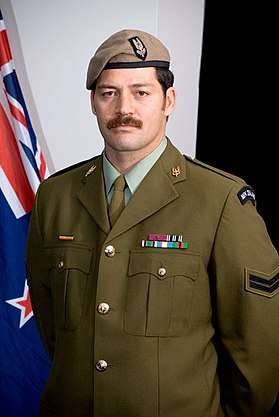
New Zealand
Royal New Zealand Navy -
- Dark blue - Military police
- Dark blue/black - All other branches
New Zealand Army -
Pre 2002 beret colours -
- Khaki - Royal Regiment of New Zealand Artillery
- Green - Royal New Zealand Infantry Regiment
- Jet black - Royal New Zealand Armoured Corps
- Royal blue - Royal New Zealand Military Police
- Red - Regular Force Cadet School
- Rifle green - Royal New Zealand Corps of Signals
- Grey - Royal New Zealand Nursing Corps
- Cypress green - New Zealand Intelligence Corps
- Sand or 'ecru'[34] - New Zealand Special Air Service
- Dark blue - All other corps
Post 2002 beret colours -
- Sand or 'ecru'[34] - New Zealand Special Air Service
- Dark blue - Royal New Zealand Military Police
- Rifle green - All other corps
Royal New Zealand Air Force -
The RNZAF does not currently wear berets except for;
- Dark blue - Military police
Nicaragua
The Nicaraguan Armed Forces wear berets in the following colours:
Berets in Nicaraguan Army:
- Green — Special Forces (COE)
- Black - Generals of Staff's Protection VIP
Berets in Nicaraguan Navy:
- Dark Blue — Special Naval Forces
Nigeria
- Dark Green — Army
- light red. - Military Police
- Dark red. - medical
- Dark blue. - Artillery
_(2).jpg)
Norway
The Norwegian armed forces use the beret as a garrison cap, but some units (mostly armored vehicle personnel) also use it in the field. The Norwegian beret and all other headwear except those of the Navy and His Majesty The King's Guard always have the current king's cipher as a badge in gold (most of the army) or silver (the air force); currently this is a numeral 5 inside an H, for "Harald V". The navy has a crowned gold anchor for their enlisted personnel, a crowned gold anchor surrounded by a circle of rope for their petty officers, and a crowned golden anchor surrounded by leaved branches for officers. The colours used are:
- Royal blue — Brigade Nord (except cavalry troops, intelligence troops and military police)
- Umbra green — Border Guards
- Black — Cavalry, armoured battalion and KESK
- Khaki — Norwegian Army 2nd Battalion
- Emerald green — Telemark Battalion
- Maroon — Army Ranger Command
- Red — Military police
- Olive green — formerly used by other army units & Home Guard
- Grey — Home Guard
- Olive green with silver badge — recruits in His Majesty's The Kings Guards; Krigsskolen
- Dark blue — Royal Norwegian Navy
- Air force blue — Royal Norwegian Air Force Base Defence Units
- Air force light blue — Royal Norwegian Air Force Air Defence Artillery Units
The special operations units of the Navy wear the same berets as the rest of the navy. However they have a coloured patch behind the cap badge, the colour of which determines the unit:
- Green — Marinejegerkommandoen
- Blue — Minedykkerkommandoen
- Maroon — Kystjegerkommandoen
- Red - Military Police
Pakistan
- Rifle green — Frontier Force Regiment, Defence Services Guards
- Rifle green with cherry color patch behind the badge - Baloch Regiment
- Green with Green Plume — Punjab Regiment
- Cherry Pink with a red feather hackle — Sindh Regiment
- Green with red patch behind badge — Azad Kashmir Regiment
- Chitrali Style with White Feather — Northern Light Infantry
- Black — Regiments of Armored Corps
- Dark Blue — Regiment of Artillery, Corps of Electrical and Mechanical Engineers, Corps of Signals
- Maroon — Army Air Defence, Army Aviation Corps
- Light Blue — Pakistan Army Corps of Engineers, Army Services Corps
- Red — Pakistan Army Medical Corps, Military Police
- Dark Maroon - Special Service Group (SSG)
- Green with Red Plume - Pakistan Military Academy Cadets
- Dark Blue - Worn by the General Staff officers (rank of Colonel and above) irrespective of their Regimental association.
Paraguay
The Paraguayan Armed Forces wear berets in the following colours:[35]
Berets in Paraguayan Army:
- Green — Paratroopers
- Dark Blue - Presidential Guard[36]
Berets in Paraguayan Navy:
- Camouflage — Special Naval Forces
Berets in Paraguayan Air Force:
- Red - Air Force Infantry and Airborne personnel
Panama
Berets were widely worn by many units in the Panamanian Defense Force (PDF) under Manuel Noriega. The PDF was abolished in February 1990, and with it all of the old military units stood down. Unique beret insignia were never approved, so units authorized to wear berets wore a combination of the approved shoulder insignia, as well as rank and qualification insignia (e.g. parachutist wings) on the berets. The following were being worn at the time of the 1989 invasion:
- Black - 7th Infantry Company "Macho de Monte"; Comando Operacional de Fuerzas Expeciales (COFFEE - Special Forces Command)
- Maroon - Battalion 2000; 2nd Airborne Infantry Company "Puma"; 3rd Infantry Company "Diablo Rojo"
- Lime Green - 4th Infantry Company "Urraca"
- Camouflage - 7th Infantry Company "Macho de Monte"; Comando Operacional de Fuerzas Expeciales (Cadre)
Philippines
| Color | Wearer | |
|---|---|---|
| Army green | Philippine Army Units, Special Operations Command | |
| Olive drab | Special Forces | |
| Olive green | Light Reaction Regiment | |
| Black | 1st Scout Ranger Regiment, Mechanized Infantry Division, Army units assigned to the Presidential Security Group | |
| UN Blue | AFP personnel assigned to UN Peacekeeping Operations, Cadets of the Peacekeeping Operations Center | |
| Color | Wearer | |
|---|---|---|
| Dark Blue | Air Force Base Security personnel | |
| Camouflage | Pararescue | |
| Black | 710th Special Operations Wing, Air Force units assigned to the Presidential Security Group | |
Poland
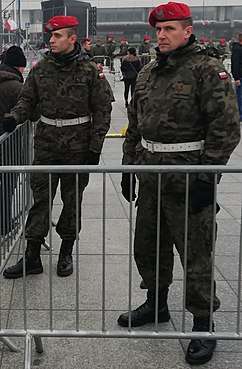
Black berets were introduced before World War II for tank and armoured car crews. During World War II, berets were widely adopted in the Polish Army on the Western Front, armored troops - black, airborne - grey, commando - green. After the war in the communist era, berets were worn only by armoured units (black), navy for field and work uniform (black), paratroopers (maroon), and marines (light blue). After 1990, the beret became the standard headgear in the Armed Forces of Republic of Poland. Around the year 2000 the design of the Polish Army Beret changed, the beret sewn together from three pieces of material with four air holes, two at each side was changed to a smaller beret molded from one piece of material with no air holes. The following colours are in use:
| Colour | Wearer | |
|---|---|---|
| Black | Armored troops, Navy, Military Unit Formoza (for field and work uniform) | |
| Blue | 7th Coastal Defense Brigade, Peacekeeping Missions Training Center | |
| Brown | Territorial Defence (discontinued) | |
| Olive Green | Territorial Defence (present) | |
| Green | Army general use | |
| Dark Green | Special Forces Command | |
| Light Grey | Military Unit GROM (JW GROM) | |
| Steel Grey | Air Force (no longer in use, replaced by camouflage side cap) | |
| Maroon | Paratroopers | |
| Scarlet Red | Military Police | |
Berets in other ministries:
| Colour | Wearer | |
|---|---|---|
| Black | Border Guards Naval Units, Firefighters (for service dress) | |
| Light Green | Border Guards (no longer in use, replaced by camouflage cap) | |
| Steel Grey | Border Guards Air Units | |
| Sapphire | Government Protection Bureau (no longer in use) and the Ministry of Internal Affairs' Troops (disbanded) | |
| Navy Blue | Police anti-terrorist units (SPAP) | |
The black beret is also the distinctive headgear of World War II veterans, particularly Armia Krajowa veterans.
The dress code of the Polish armed forces states than when not worn on the head or kept in a locker the beret should be placed under the left shoulder loop. This practice was discontinued due to introducing new field uniform (wz. 2010) with rank insignia placed on chest.
Portugal
The beret was first introduced in the Portuguese Armed Forces in 1956, when the Air Force Paratroopers adopted the green beret. The Portuguese Army adopted the brown beret for its Caçadores Especiais special forces in 1960, generalizing its wear to all units in 1962. The following colors of berets were or are still worn by the Portuguese Military and Paramilitary forces:
| Army | ||
|---|---|---|
| Colour | Wearer | |
| Brown | Caçadores Especiais in 1960–1962;
Army general use since 1962
| |
| Black | Cavalry branch and Army Police (Lancers Regiment )
Provincial organization of volunteers and civil defence until 1975 | |
| Green | Army Paratroopers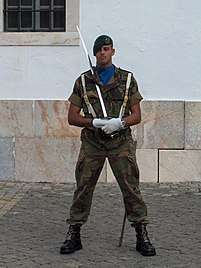 Portuguese Paratrooper ( green beret ) in guard duty | |
| Red | 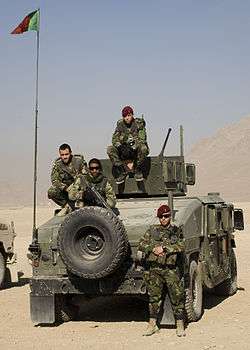 Portuguese Commandos ( red beret ) in Afghanistan | |
| Moss/
dry green |
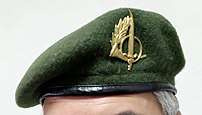 Special Operations Forces (Army Rangers) moss/ dry green beret | |
| Navy | ||
| Blue | Navy | |
| Ferrete
(Dark blue) |
 Portuguese Marine Corps (dark blue beret) on parade | |
| Air Force | ||
| Light blue | Air Force Police | |
| GNR - National Republican Guard ( Portuguese Gendarmerie ) | ||
| Dark green | GNR general use since 2013 | |
| Beige | GIPS (GNR rescue unit) until 2013 (still worn unofficially since then) | |
| International | ||
| UN blue | Personnel serving with the United Nations on international peacekeeping missions | |
| Decommissioned | ||
| Yellow | Special Groups of Mozambique until 1975 | |
| Maroon | Paratrooper Special Groups until 1975 | |
| Camouflage | Guinea 3rd and 5th Commando and native caçadores companies (unofficial) in 1966–1968, Flechas until 1975 | |
| White | Volunteer Aerial Formations until 1975 | |
Rhodesia
Zimbabwe-Rhodesia made changes to the army in 1979 and shortly after Zimbabwe disbanded all the regiments Rhodesian Security Forces in favour of the Zimbabwe Defence Forces in 1979–1981.
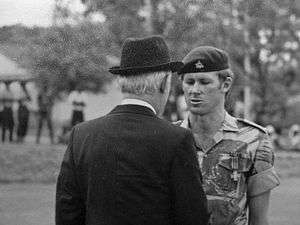
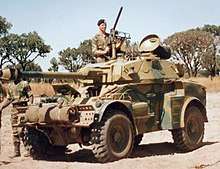
Up to this point the Security Forces wore the beret as the primary working dress and service dress headgear. Like most countries formerly associated with the British Empire, Berets were coloured according to unit or service branch, with a distinctive regimental cap badge pinned above the left eye. The Rhodesian Security Forces were integrated into the new Zimbabwe Defence Forces in 1980.
Rhodesia introduced the brown beret as a new colour for specialist berets, for use of the Selous Scouts, which has since been used for specialist units in the Finnish and Brazilian forces, and with the New Zealand SAS
Rhodesian beret colours were as follows:
| Colour | Wearer | |
|---|---|---|
| Grey | Grey Scouts | |
| Brown | Selous Scouts | |
| Black | Rhodesian Armoured Corps | |
| Maroon | Medical Corps | |
| Beige | Special Air Service | |
| Scarlet | Internal Affairs Ministry and the Rhodesian Military Police | |
| Green | Most infantry regiments, including the Rhodesian Regiment and the Rhodesian African Rifles | |
| Tartan Green | Rhodesian Light Infantry (from 1964, when they were designated a commando regiment) | |
| Dark blue | Generic - worn by all other units of the Army | |
| Blue Grey | Rhodesian Air Force | |
| Bright Blue | Psychological Operations | |
Like the United Kingdom, Rhodesia also used flashes and hackles behind cap badges on their berets as well such as:
- The blue, yellow and red shield on the medical corps beret.
- The blue diamond flash on the military police beret
- The red outline of the Rhodesian Artillery beret
- The red tombstone of the Grey Scouts beret
- The red diamond hacking of the Rhodesian Regiment beret (similar to that of the KRRC)
- The Blue and Red hackle of the 4th Battalion Rhodesian Regiment Beret.
Romania
_during_a_Raven_UAV_familiarization_flight_at_the_Romanian_Land_Forces_facility_in_Buzau%2C_Romania%2C_June_2%2C_2011_110602-M-GN320-005.jpg)
| Colour | Wearer | |
|---|---|---|
| Black | Anti-air Artillery and Missiles, Artillery, Military Automobile Troops (automobilişti militari), Tanks, Communication and Informatics structures, Engineers, Nuclear Biological and Chemical (NBC) Defense and Naval Forces | |
| Green | Mountain Troops (or Mountain Hunters, Vânători de Munte), Special Operations Forces | |
| Dark Blue | Military Justice, Romanian Gendarmerie (Jandarmeria Română) | |
| Maroon | Paratroopers | |
| Red | Military Music | |
| Dark red (bordeaux red) | Military Medicine | |
| Violet | Military Logistics, or administration (intendenţă) | |
| Light Grey | Military Police | |
| Light Blue | Air Force and Radar Troops (radiolocaţie) | |
| Dark brown | Infantry | |
Russia
In the Soviet Union berets were sewn together from three pieces of material with four air holes, two at each side, worn with the service badge centered between the eyes and draped to the right in most circumstances. When appearing in public on parade, the berets were draped to the left side so that the insignia shows to observing dignitaries and the public. Berets were worn only by:
| Colour | Wearer | |
|---|---|---|
| Black | Naval infantry, tank troops (only for coveralls), OMON special militia units | |
| Sky blue | Airborne troops | |
| Raspberry | Airborne troops (till 1969, unofficially from 1963 with jump uniform only) | |
| Green | 103rd Airborne Division (while subordinate to Border Guards in 1989-91) | |
| Rust red (orig. Krapovyi) | MVD special troops (from end of the 1980s) | |
| Blue | Navy (WMF) - as a part of working and technical uniform for enlisted and petty officers (officially matrosy i starshiny in Russian) | |
During this period berets were also worn by female personnel of the Armed Forces for everyday and parade uniform. The colour of the beret corresponded with that of the main uniform (e.g. Army and Air Force everyday uniform - olive, Navy uniform - navy blue or white, Army parade uniform - sea green, Air Force parade uniform - dark blue).

The Soviet-era beret color scheme detailed above (e.g. for airborne troops and naval infantry) remained in effect in post-1991 Russia. In the late 1990s the Russian Ministry of Extreme Situations introduced orange berets for its own troops.
In 2011 the Russian defence ministry authorised the wearing of berets by all non-naval military personnel as part of their field uniforms.
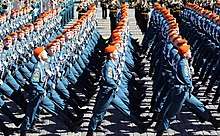
The current beret colour scheme is:
| Colour | Wearer | |
|---|---|---|
| Black | Naval Infantry (Russia), OMON and SOBR units of the National Guard of Russia, FSB counter-terrorist units | |
| Sky blue | Russian Airborne Troops general issue berets, Spetznaz units of the Russian Ground Forces (will often wear headwear of other units in the field to avoid identification) | |
| Cornflower blue | Special units of Federal Security Service, Federal Protective Service and Presidential Regiment | |
| Light green | Border Guard Service of Russia | |
| Dark green | Armed Forces reconnaissance units - soldiers are allowed to wear this beret after passing special tests | |
| Olive | Russian Ground Forces standard beret, Strategic Missile Troops, Russian Aerospace Defence Forces, Russian Air Force, Russian Railway Troops | |
| Orange | Ministry of Emergency Situations general issue berets | |
| Rust red (orig. Krapovyi) | 604th Special Purpose Center, 7th OSN, 19th OSN of the National Guard Forces Command Spetsnaz - soldiers are allowed to wear this beret after passing special tests | |
| Bright red | Military Police (since 2010), Young Army Cadets National Movement | |
Saudi Arabia
.jpg)
| Colour | Worn by[37] | |
|---|---|---|
| Olive Green | Royal Saudi Land Forces | |
| Dark Blue | Royal Saudi Air Force | |
| Black | Royal Saudi Navy | |
| Dark Green | Royal Saudi Air Defense | |
| Red | Military Police of the Armed Forces of Saudi Arabia | |
| Maroon | Paratroopers Units and Special Security Forces | |
Senegal
- Tan/sand - Bataillon de Parachutistes (Army Parachute Battalion)
- Brown - Bataillon de Commandos (Army Commando Battalion)
- Black - Detachment Forces Speciales (Special Forces Detachment)
- Orange - Groupement Mobil d'Intervention (Mobile Intervention Group)
- Blue - Legion de Gendarmerie d'Intervention (Gendarmerie Intervention Unit)
- Green - Compagnie Fusilier de Marine Comandos (COFUMACO)(Navy Marine Commandos)
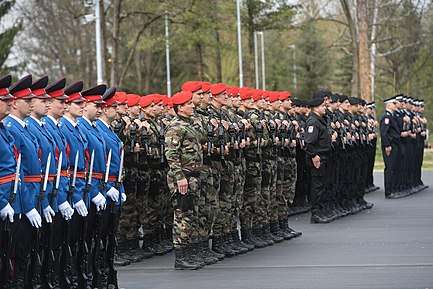
Serbia
The Serbian Armed Forces are wearing berets in the following colours:
- Olive green — Army
- Black — Military Police
- Maroon — 72nd Brigade for Special operations
- Red - 63rd Parachute Brigade
- Steel blue — Air Force
- Navy blue — Navy
Singapore

The Singapore Armed Forces and Singapore Police Force adopts the beret as their standard headgear. The different color divisions are as follows:
| Colour | Wearer | |
|---|---|---|
| Olive Green | Infantry Regiment (Previously Dark Green) | |
| Black | Armoured Regiment | |
| Khaki | Guards | |
| Red (Crimson) | Commandos | |
| Red (Burgundy) | Police Tactical Unit | |
| Dark Blue | Signals Formation, Artillery, Combat Engineers, Medical Corps, Transport and Logistics, Military Police, SAF Volunteer Corps, Navy, Singapore Police Force, Police Gurkha Contingent | |
| Air Force Blue (Bluish Grey) | Air Force | |
| Light Grey | Public Transport Security Command | |
| UN Blue | UN Peacekeeping Force | |
| Cream | Protective Security Command | |
The berets are all adorned with the Singapore Armed Forces coat of arms, with the exception of the Air Force beret, Military Police beret, navy beret and police beret which are adorned with their respective cap-badge. Officers in the navy have a different cap-badge from the ratings. Officers of the rank of colonel and above have a different cap-badge.
- National Cadet Corps (Land)- Green
- National Cadet Corps (Air)- Blue
- National Cadet Corps (Sea)- Black
- National Police Cadet Corps- Dark Blue
- National Civil Defence Cadet Corps- Black
All berets have the National Cadet Corps, National Police Cadet Corps or National Civil Defence Cadet Corps crest on the front.
Slovakia
| Colour | Wearer | |
|---|---|---|
| Black | tank forces, army air defense | |
| Green | units of high readiness, immediately reaction battalion | |
| Dark Blue | military police | |
| Maroon | paratrooper units,5.regiment of special assignment(airborne) | |
| UN Blue | Personnel serving with the United Nations on international peacekeeping missions | |
Slovenia
- Rifle Green - Special forces
- Green — Military Police
- Olive green - Signal units
- Black - Armour units
- Maroon - motorised infantry/Paratroopers
- Dark blue — Navy units
- Light blue — Air force
- Grey - Mountain units
- Sand - NBC units
- Red - Guard unit
Somalia
The Somali Armed Forces has the beret has the standard headgear since its inception in 1960. Each function within the security forces of Somalia has a unique colour.
| Colour | Wearer | |
|---|---|---|
| Black | Logistics (Army), Navy | |
| Blue | Police | |
| Red | Presidential Guard | |
| Khaki | Infantry | |
| Slate | National Intelligence and Security Agency Special Forces | |
| Green | Custodial Corps | |
| Navy | Air Force | |
| Maroon | General Issue | |
| Sky blue | TURKSOM candidates and graduates | |
South Africa
The South African Army wears the beret as its standard headgear. The different color divisions are as follows:
| Colour | Wearer | |
|---|---|---|
| Black | Armour, Intelligence | |
| Dark Green | Infantry | |
| Red | Military Police | |
| Dark Blue | Artillery | |
| Light blue | Logistics | |
| Olive | Munnitions Corps | |
| Light Maroon | Military Health Services | |
| Beige | Signal Corps | |
| Purple | Chaplain Corps | |
| Orange | Human Resources, Mechanics | |
| Maroon | Parachute Infantry, Special Forces | |
| UN blue | Personnel serving with the United Nations on international peacekeeping missions | |
The berets are all adorned with the unit's insignia. Some of the traditional units wear other headgear - for example, the Cape Town Highlanders Regiment and the band of the South African Military Health Service.
Outside of Army, the South African Military Health Service wear light maroon berets. The South African Special Forces Brigade which is a separate entity, not part of the army, also wear the Maroon beret which is traditional for elite units in the western world.
South Korea
Berets are worn by members of the Republic of Korea Army and some elite units of the South Korean Military, including:
- Black — Army Republic of Korea Army Special Warfare Command (with yellow backing), Reserve Officer Training Corps, KATUSA (Korean Augmentation to the United States Army)
- Dark Green — Army
- Dark Blue - Air Force Military Police
- Red — Air Force Combat Control Team (CCT)
- Maroon — Air Force Special Air Rescue Team (SART)
- Green — Marine Corps Force Reconnaissance, Marine Corps armoured units
- Grey — Navy UDT/SEAL Team (Naval Special Warfare Flotilla)
- Camouflage — Army armoured units
- reddish brown - Army aviation
- UN Blue - United Nations peacekeepers
Other than these units, several secret commando units (mostly disbanded in the mid-1990s, among them the "Unit 684" which became infamous for its mutiny) formed to infiltrate North Korea during the Cold War days wore black berets and adorned them with the badges of individual units. Korean liaison soldiers serving in the U.S. Eighth Army (KATUSA) have also been wearing black berets along with American uniforms since that beret became a standard headgear of the U.S. Army in 2001.
South Vietnam
American advisers assigned to these units wore the berets.[38]
- Red — Paratroopers
- Green — Marines, LLDB
- Maroon — Rangers
- Black — Navy Junk Force
- Black — Palace guards
- Tan — political officers
Spain
The beret is used in the various armed forces of Spain. The colours used are:[39]
| Colour | Wearer | |
|---|---|---|
| Black | Airborne Brigade (BRIPAC), Mechanized Division "Brunete", Air Force Police. | |
| Maroon | 1st King's Immemorial Infantry Regiment of AHQ. | |
| Royal Blue | Royal Guard, Army Helicopters (FAMET). | |
| Ash Grey | Ciberdefence Joint Command.[40] | |
| Mustard | Military Emergencies Unit (UME). | |
| Red | General Military Academy | |
| Green | Mountain Brigade (Jefatura de Tropas de Montaña). | |
| Dark Green | Special Operations units (MCOE,MOE, UOE, EZAPAC). | |
| Olive | Spanish Army general issue berets. | |
| Brown | Military Police. | |
| Tan | BRILCAN (Brigada de Infantería Ligera Canarias XVI). | |
| Grey | BRILAT (Brigada de Infantería Ligera Galicia VII). | |
Sri Lanka
- Maroon — Army Commando Regiment
- Black — Sri Lanka Armoured Corps, Army Special Forces Regiment, Navy Special Boat Squadron, Air Force Regiment Special Force
- Commando Green - , Sri Lanka Sinha Regiment, Mechanized Infantry Regiment, Military Intelligence Corps, Sri Lanka Army Women Corps, Sri Lanka Rifle Corps, Special Task Force
- Green - Gajaba Regiment (Infantry)
- Blue - Vijayabahu Infantry Regiment, The Gemunu Watch (Infantry) & All Other Ranks of Artillery, Engineers, Signals, Light Infantry & all Service Corps
- Khaki - All Officers of Sri Lanka Artillery, Corps of Engineers, Corps of Signals, Light Infantry, Service Corps, Corps Engineer Services, General Service Corps, Electrical & Mechanical Engineers, Sri Lanka National Guard, Sri Lanka Army Pioneer Corps
- Red - Military Police
- Dark Blue - Sri Lanka Air Force
Sweden
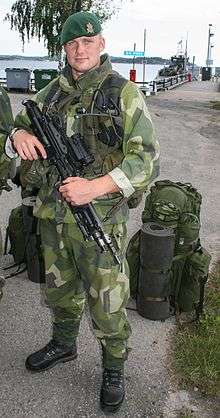
The beret is used in the various armed forces of Sweden. The colours used are:[41]
| Color | Wearer | |
|---|---|---|
| Dark blue | Generals in the army and amphibious corps, all other military units not assigned another beret color, except for the navy | |
| Black | Life Guard Regiment (Infantry), Armored/mechanized Regiments, Land Warfare Center. | |
| Rifle green | Life Guard Regiment (Cavalry), Air-mobile Battalion (LBB), ISTAR Battalion, Army Ranger Battalion, | |
| Commando green | Amphibious Corps | |
| Maroon | Parachute Ranger | |
| Khaki | Home Guard | |
| Scarlet | Life Guard Regiment (Musicians) | |
| Bright blue | Armed Forces Helicopter Wing | |
| Olive green | Special Operations Group (SOG) (Special Forces) | |
| UN blue | Military personnel in UN-service | |
| Yellow | EU monitors etc. | |
Sudan
The beret is worn by all police and military personnel.
- Maroon - Paratroops
- Pink - special police
Switzerland
Since 1995, when it replaced the grey side cap, the beret is worn with the dress uniform and with the personally issued battle dress uniform by all Swiss soldiers. In training, a black beret (without insignia) is worn by mechanised units, otherwise a camouflage-coloured field cap is worn instead.
The colours used are:[42]
- Black — armoured and mechanised units; signals and headquarters troops; NBC specialists; intelligence, military justice and general staff personnel
- Green — infantry, musicians
- Red — artillery
- Deep blue — Air Force (including paratroopers)
- Blue — medical personnel
- Dark red — logistics troops
- Grey — military police
- Light blue — troops on UN missions
- Tan (Sand) - Special Operation Forces
Thailand
The beret is used in the various armed forces of Thailand. The colours used are:
- Maroon — Airborne units, 1st Special Warfare Division, 31st Ranger Regiment
- Khaki green — Army Reserve Force Students
- Black — all other Army units, Air Force, Thahan Phran, Airborne Police units, Border Patrol Police (BPP)
- Camouflage — Royal Thai Marine Corps and Navy SEALs
- Navy Blue - Volunteer Defense Corps (VDC) Part of Department Of Provincial Administration (DOPA), Ministry of Interior
- UN Blue - Personnel serving with the United Nations on peacekeeping missions
The black beret is also worn by ordinary police in certain situations.
Togo
The beret colours worn by the Togolese Army are as follows:
- Black — Armoured Corps.
- Maroon — Para-Commando Regiment.
- Green — Presidential Guard Commando Regiment.
- Dark Blue - All other Arms and Corps
Turkey
The beret is used in the various armed forces of Turkey. The colours used are:[37]
- Black: Armoured Corps of Turkish Land Forces.
- Blue: Elite units of Turkish Armed Forces.
- Dark-Blue: Personnel of General Directorate of Security riot team and Police Counter Attack Team.
- Navy-Blue: VIP guard team of the Turkish Air Force.
- UN Blue: Personnel serving with the United Nations.
- Green: Personnel of Gendarmerie General Command and General Directorate of Security.
- Bluish-Green: Personnel of Police Special Operation Department.
- Dark-Green: Overseas deployment personnel of Turkish Armed Forces.
- Maroon: Personnel of Special Forces Command.
- Red: Personnel of National Intelligence Organization.
- Tan: CSAR units of the Turkish Air Force.
Ukraine

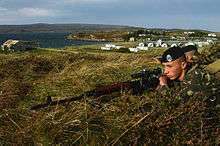
The beret is used in the various armed forces of Ukraine. The Ukrainian armed forces formerly wore a Soviet style beret sewn together from three pieces of material with four air holes, two at each side, was changed to a smaller beret molded from one piece of material with no air holes. The colours are:
- Maroon - Ukrainian Air Assault Forces, formerly wore light blue
- Black - Ukrainian Naval Infantry
United Arab Emirates
The Armed Forces of the UAE and National Service use berets with distinct colours to display the specific branch of the armed forces. All berets displays the United Arab Emirates Armed Forces emblem.[43]
Emirati military personnel may also choose to wear military camo coloured ghutra in a turban fashion in keeping with traditional Arabic attire.
The colours are as follows:
| Colour | Wearer | |
|---|---|---|
| Blue | United Arab Emirates Navy | |
| Green | Military recruit | |
| Red | Military police | |
| Sky Blue | United Arab Emirates Air Force | |
| Maroon | Presidential Guard | |
| Tan | United Arab Emirates Army and Medical Corps. | |
United Kingdom

The British Army beret dates back to 1918 when the French 70th Chasseurs alpins were training with the British Tank Corps. The Chasseurs alpins wore a distinctive large beret (see above) and Major-General Sir Hugh Elles, the TC's Colonel, realised this style of headdress would be a practical option for his tank crews, forced to work in a reduced space. He thought, however, that the Chasseur beret was "too sloppy" and the Basque-style beret of the French tank crews was "too skimpy", so a compromise based on the Scottish tam o'shanter was designed and submitted for the approval of George V in November 1923. It was adopted in March 1924.
During the Second World War, the use of the black beret was extended to all the regiments of the Royal Armoured Corps in 1940. The maroon beret was adopted by the Parachute Regiment in 1941 and the green beret by the Commandos in late 1942. A khaki beret was worn by the Reconnaissance Corps from 1941 until 1944,[44] and the Royal Air Force Regiment adopted a blue-grey beret in 1943.[45] Later in the war, a rather baggier beret-like hat, called the General Service Cap, was issued to all ranks of the British Army (with RAC, parachute, commando, Scottish and Irish units excepted), to replace the earlier Field Service Cap. The GS Cap was not popular, and after the war was replaced with a true beret.[46]
Today, every British military unit wears a beret, with the exception of the Royal Regiment of Scotland and Royal Irish Regiment, who wear the tam o'shanter and the caubeen respectively (the Scots Guards and Irish Guards, however, wear berets, as frequently do the Royal Irish Regiment on operations). Many of these berets are in distinctive colours and all are worn with the cap badge of the service, regiment or corps. The cap badge for all services in the UK is usually worn directly over the left eye.


.jpg)
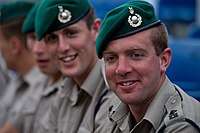
.jpg)
Beret Colours
The colours are as follows:
| Color | Wearer | |
|---|---|---|
| Khaki | Foot Guards, Honourable Artillery Company, Princess of Wales's Royal Regiment, Royal Anglian Regiment, Royal Gibraltar Regiment, Duke of Lancaster's Regiment, Royal Welsh, Yorkshire Regiment, Mercian Regiment, 4/73 (Sphinx) Special OP Battery Royal Artillery[47] | |
| Light grey | Royal Scots Dragoon Guards | |
| Dark grey | Queen Alexandra's Royal Army Nursing Corps | |
| Brown | King's Royal Hussars, Royal Wessex Yeomanry | |
| Black | Royal Tank Regiment, C&S (Westminster Dragoons) Squadron, Royal Yeomanry | |
| Rifle green | The Rifles, Royal Gurkha Rifles, The Royal Dragoon Guards, Small Arms School Corps, 36 (Essex Yeomanry) Signal Squadron | |
| Maroon | Parachute Regiment, All ranks serving with 16 Air Assault Brigade | |
| Beige | Special Air Service including attached troops who are not SAS-qualified (a white beret was briefly worn on formation of the regiment in 1942 and a maroon beret from 1944 to 1956) | |
| Emerald grey | Special Reconnaissance Regiment | |
| Cambridge blue | Army Air Corps, 47 Regiment Royal Artillery, some elements of Royal Electrical Mechanical Engineers[48][49] | |
| Cypress green | Intelligence Corps | |
| Scarlet | Royal Military Police | |
| Green | Adjutant General's Corps (except Royal Military Police, who wear scarlet; Army Legal Services Branch, who wear black; and Military Provost Guard Service, and Educational and Training Services branch, who wear navy blue), Military Provost Guard Service | |
| Dark blue | Generic: worn by all other Army units (except Scottish and Irish line infantry regiments), Royal Navy, Royal Marines who are not yet commando-qualified (and who wear the Royal Marines capbadge with red backing), Sea Cadet Corps | |
| Commando green | Commando-qualified Royal Marines, Commando-qualified personnel of all services serving in 3 Commando Brigade, Special Boat Service | |
| RAF blue grey | Royal Air Force (including RAF Regiment), Air Cadets (Combined Cadet Force and Air Training Corps[50]) | |
| UN Blue | Personnel serving with the United Nations on peacekeeping missions | |
General rule for wearing a British Army berets taught at training depots is to shape the head dress back and to the right for the material and to have the leather band level around the head with the cap badge two fingers above the left eye. Scottish Infantry have different rules for the Tamo'shanter with the cap badge worn on the left side of the head.
Other Adornments
Some Regiments and Corps wear a coloured backing behind the capbadge. These include:
- Foot Guards - Blue Red Blue patch (less the officers of the Scots Guards, who wear a patch of Royal Stewart tartan)
- Honourable Artillery Company - Black Circle
- Princess of Wales's Royal Regiment - Blue Yellow Blue Patch
- Royal Anglian Regiment - Small Black 'Tombstone'
- Queen Alexandra's Royal Army Nursing Corps — Red Patch
- Royal Army Medical Corps - Dull Cherry Oval Patch
- Army Air Corps - Black Patch
- Army Physical Training Corps - Patch in Corps Colours
- Royal Marines 'Red Tombstone' (only on dark blue beret worn by those who are not yet commando-qualified)
- Royal Welsh Regiment and Mercian Regiment - Green badge outline and square respectively
- Queen's Royal Lancers - Red Patch
- Household Cavalry - Blue Red Blue patch
- The Royal Dragoon Guards - Red Diamond Patch
- Yorkshire Regiment - Brunswick (British Racing) Green.
- Royal Scots Dragoon Guards - Black patch (Worn in mourning for Tsar Nicholas II, the last Tsar of Russia, who was their Colonel-in-Chief at the time of his murder)
- King's Royal Hussars - Red Patch
- Royal Wessex Yeomanry All ranks, from all 4 Squadrons wear a black patch behind the cap badge, as a 4 sqdns retain individual cap badges B (RWY) and D (RDY) wear a red flash between the black square and badge.
The Royal Regiment of Fusiliers, the only remaining independent fusilier regiment, wears a feather hackle on the beret. Other ranks of the Royal Welsh also wear hackles.
- Parachute regiment, soldiers awaiting phase 2 training to attend P company wear a green oval behind the capbadge.
Members of the Royal Tank Regiment, 4/73 (Sphinx) Special OP Battery Royal Artillery,[51] Royal Regiment of Fusiliers, Army Air Corps, Parachute Regiment, SAS and Intelligence Corps wear berets in Nos 1, 2, 3 and 6, Dress. Other English and Welsh Regiments and Corps wear peaked caps in these orders of dress.[52] Troops from other services, regiments or corps on attachment to units with distinctive coloured berets often wear those berets (with their own cap badge). Colonels, brigadiers and generals usually continue to wear the beret of the regiment or corps to which they used to belong with the cap badge distinctive to their rank.
Old Units
Former regiments and corps, now amalgamated:
- Dark Blue - Queens Regiment, Royal Hampshire Regiment
- Khaki — Green Howards, King's Own Royal Border Regiment, Prince of Wales's Own Regiment of Yorkshire, Duke of Wellington's Regiment, Reconnaissance Corps, infantry motor battalions in World War II
- Dark (Rifle) green — Light Infantry, Royal Green Jackets, Devonshire and Dorset Light Infantry, Royal Gloucestershire, Berkshire and Wiltshire Light Infantry, Rifle Brigade, King's Royal Rifle Corps, 2nd King Edward VII's Own Gurkha Rifles (The Sirmoor Rifles), 6th Queen Elizabeth's Own Gurkha Rifles, 7th Duke of Edinburgh's Own Gurkha Rifles, 10th Princess Mary's Own Gurkha Rifles
- Black — all Royal Armoured Corps regiments in World War II (other than officers in Inns of Court Regiment), Royal Observer Corps, Westminster Dragoons, Berkshire and Westminster Dragoons
- Maroon — Glider Pilot Regiment and glider-borne units
- Green — Women's Royal Army Corps, women in Officers Training Corps (now wear dark blue), officers in Inns of Court Regiment
- Brown with a broad crimson headband and NO hat badge - 11th Hussars (PAO)
United States
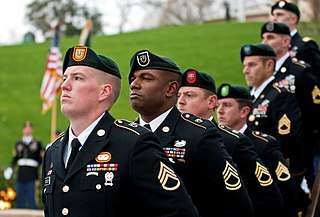
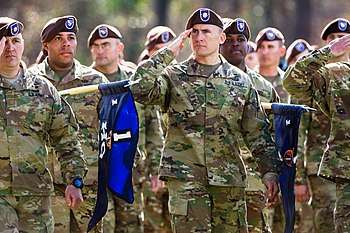
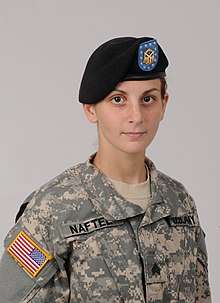

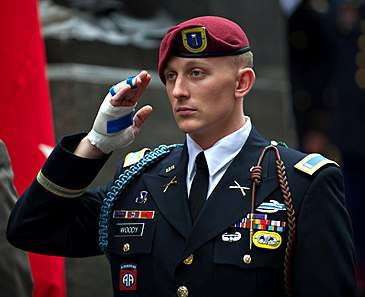
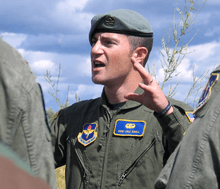

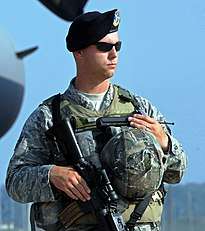
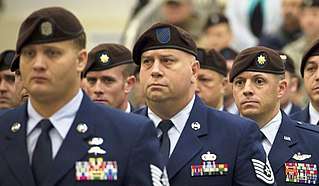

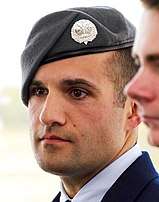
Berets were originally worn by select forces in the United States Army. The first were worn during World War II, when a battalion of the 509th Parachute Infantry Regiment were presented maroon berets by their British counterparts.[53] Though unofficial at first, the green beret of the US Army Special Forces was formally adopted in 1961. Maroon airborne and black US Army Ranger berets were formally authorized in the 1970s.
"D" Troop 17th Cavalry were authorized a maroon beret in Vietnam.[54]
After the Vietnam War, morale in the US Army waned. In response, from 1973 through 1979 HQDA permitted local commanders to encourage morale-enhancing uniform distinctions, however these distinctions were only allowed to be worn on the post. Consequently, many units embraced various colored berets, for example Armor and Armored Cavalry units often adopted the black beret. Similarly many other units embraced various colored berets in an attempt to improve dwindling morale. In particular, the First Cavalry Division assigned various colored berets to its three pronged TRICAP approach. In this implementation, Armored Cavalry, Airmobile Infantry units, Air Cavalry units, Division Artillery units, and Division Support units all wore different colored berets, including black, light blue, kelly green, and red. The 101st Airborne Division was authorised a dark blue beret.
In 1975 all female soldiers of the Women's Army Corps were authorized to wear a black beret variant as standard headgear for the service uniform.[55]
In 1975 the 172nd Light Infantry Brigade at Fort Richardson & Fort Wainwright, Alaska wore Olive Drab Berets.
In 2001, Army Chief of Staff Eric Shinseki ordered the black beret worn as standard headgear army-wide, a controversial decision because it was previously reserved for the Rangers. The Rangers were then authorized to wear a tan beret, exclusive to them. The decision was implemented in hopes of boosting morale among conventional units. However, many soldiers began complaining that the new black beret was not practical with the utility uniform. In June 2011, Army Secretary John McHugh, acting on the recommendations made by Chief of Staff Martin Dempsey and Sergeant Major of the Army Raymond F. Chandler, once again chose the traditional patrol cap to be worn with the utility uniform. The black beret may be authorized with utility uniforms at commander's discretion for special ceremonies. The beret remains part of the Army's dress uniform for all units.
United States Army berets now use the following distinctive colors:
| Color | Wearer | |
|---|---|---|
| Rifle green | Special Forces qualified soldiers | |
| Tan | Soldiers assigned to the 75th Ranger Regiment and the Airborne and Ranger Training Brigade (Soldiers that have served one year in the regiment and are assigned to a USASOC component may continue to wear the Tan Beret.) | |
| Maroon | Soldiers assigned to units on active "jump status," better known as Airborne/Parachute units | |
| Brown | Soldiers assigned to the Security Force Assistance Command and its subordinate units | |
| Black | Worn by all soldiers with Army Service Uniform as standard headgear (The patrol cap is the standard headgear with utility uniforms such as the ACUs; however, the black beret may be authorized with utility uniforms at commander's discretion.[56]) | |
Special Forces, Ranger, and Airborne unit berets sport distinctive organizational flashes. All other units use a standard pale blue flash bordered with 13 white stars. Officers wear their rank insignia within the flash, while enlisted ranks wear their distinctive unit insignia.
| Color | Wearer | |
|---|---|---|
| Black | Tactical Air Control Party (TACP) | |
| Maroon | Pararescue and Combat Rescue Officer | |
| Scarlet | Combat Controller and Special Tactics Officer | |
| Pewter Grey | Special Reconnaissance | |
| Dark Blue | Security Forces, United States Air Force Academy First-Class Cadet, and Basic Cadet Training cadre | |
| Sage Green | Survival, Evasion, Resistance and Escape (SERE) Specialists | |
| Brown | Airmen assigned to units designated as Combat Aviation Advisors[57] | |
In the United States Navy, female officers and sailors were allowed to wear black berets instead of a combination hat or garrison cap while in service uniforms until 2016. The black berets were phased out in October of that year due to a lack of widespread use and a desire by the U.S. Navy to make its uniforms more unisex in appearance. During the Vietnam War, the U.S. Navy created special boat teams, unofficially dubbed the brown-water navy, to patrol coastlines, estuaries and rivers. Naval personnel assigned to these teams wore black berets as part of their uniform, as portrayed in the movie Apocalypse Now.[58] U.S. Navy SEAL teams serving in Vietnam wore camouflage berets in the field, the only beret somewhat standardized in the SEALs.
Uruguay
- Military
- Grey - Army 14th Parachute Battalion
- Green - Army 13th Armor Battalion (Combined Arms)
- Police
- Black - Police Coraceros Regiment
Vatican State
The Pontifical Swiss Guard wears large black berets.

Venezuela
Berets are worn by some units in the Venezuelan National Armed Forces, with distinctive colors for some units or functions. The beret colours are as follows:
| Colour | Wearer | |
|---|---|---|
| black | Venezuelan Army general issue berets; included, the comandos (Army special forces units). | |
| green | Army Counter-insurgency troops (caribes). | |
| red | 311th Infantry Battalion "Simon Bolivar" (Army). Wears the red beret as the first and oldest active infantry battalion of the Army. | |
| red | 42nd Airborne Brigade (Army). | |
| dark blue | Army Headquarters and Security Group (Lieutenant General Daniel Florencio O'Leary Headquarters Battalion). | |
| Colour | Wearer | |
|---|---|---|
| black | Venezuelan Marine Corps general issue berets (since 2009). | |
| Colour | Wearer | |
|---|---|---|
| blue | Venezuelan Air Force Infantry units (Infantería Aérea) and Air Force Police personnel. | |
| black | 20nd Special Forces Group (since 2016).[59][60][61] | |
| Colour | Wearer | |
|---|---|---|
| maroon | Venezuelan National Guard general issue berets. | |
| Colour | Wearer | |
|---|---|---|
| red | Presidential Honor Guard Brigade (armed forces joint unit). | |
| red | Armed Forces General Headquarters (Minister Of Defence troops (Caracas Battalion), armed forces joint unit). | |
Note: Before the conversion to the red berets, the Caracas Battalion wore dark blue berets similar to those used by the O'Leary Battalion.
Note: Bolivarian National Police general issue red berets (since 2017).
Vietnam
Berets used by the Vietnam Coast Guard and the Vietnam People's Navy are:
- Blue - Enlisted Seamen
- Black - Officers and NCOs
- Dark Blue - Marine Commandos and Naval Infantrymen
During the celebration of the 40th Reunification Day, the People's Army of Vietnam presented new models of berets:
- Green and camouflaged berets are worn by Infantry Reconnaissance troopers and Ground Commandos respectively.
- Red berets are worn by Airborne Forces.
Army's servicemen served within the United Nations will bear the UN blue beret
Zambia
- Black - Armoured troops
- Green – Zambia rifles (Infantry)
- Maroon - Paracommando
- Scarlet - Military police
- Dark Blue - worn by all other Army units
- Khaki - colonels and general officers with combat uniform
- Grey-blue - Air Force personnel
- Khaki-Black – Zambia National Service personnel
Zimbabwe
- Green — Infantry
- Black — Armoured Regiment
- Maroon — Parachute Battalion
- Tartan Green - Commando Battalion
- Tan - Special Air Service
- Yellow — Presidential Guard
- Cherry Red — Military Police
- Blue-gray — Zimbabwe Air Force
- Dark Blue — All other units
International forces
United Nations
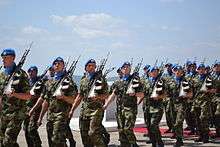
- UN blue: United Nations peacekeeping forces wear a light blue beret (in lieu of a helmet or bush hat).
Multinational Force and Observers
- Terracotta: All military members of the Multinational Force and Observers wear a terracotta-colored beret or bush hat in lieu of their normal headgear.
African Union
- Lime or light green: African Union (AU) peacekeeping forces wear a lime or light green beret. AU troops were recently seen wearing the green berets in Sudan but only for a short while. The AU peacekeeping forces were later turned over to UN administration and swapped out their green berets for UN light blue ones.[62]
See also
- Uniform beret, for the use of berets as uniform headgear outside the military
Military berets by color:
References
- Carman, W.Y. A Dictionary of Military Uniform. p. 26. ISBN 0-684-15130-8.
- Mollo, John. Military Fashion. p. 200. ISBN 0-214-65349-8.
- "Uniforms", page 587, Volume XXVII Encyclopædia Britannica, 1911 Edition
- Skinner, Rebecca (2010). British Paratrooper 1940–45. Osprey Publishing. p. 6. ISBN 978-1472805126.
- Bull, Stephen (2010). Commando Tactics: The Second World War. Pen & Sword Military. p. 98. ISBN 978-1848840744.
- "A Short History of the Use of Berets in the U.S. Army". Archived from the original on 24 June 2001.
- The Australian Army in World War II - Page 57 Mark Johnson ISBN 1472805224
- "Uniform & Kit issued to the AIF During WW2". www.medalsgonemissing.com.
- http://www.austcdoassocvic.com/history1.htm%5B%5D
- The other Cazadores de Monte brigades use Dark Green berets
- Pictures of the Argentine Armed Forces http://www.taringa.net/comunidades/naiem/7914799/Fuerzas-Especiales-Argentinas.html
- Pictures of the Argentine Armed Forces http://www.taringa.net/posts/imagenes/17507569/Cazadores-del-Ejercito-Argentino.html
- "Army Dress Manual Chapter 3 - Items of Dress, Embellishments and Accoutrements" (PDF). Australian Army. Retrieved 29 May 2020.
- "Uniform instructions for the Royal Australian Navy" (PDF). Royal Australian Navy. 2019. Retrieved 29 May 2020.
- "Air Force Vol.55, No.12" (PDF). Royal Australian Air Force. 4 July 2013. Retrieved 29 May 2020.
- "Air Force Vol.55, No.13" (PDF). Royal Australian Air Force. 18 July 2013. Retrieved 29 May 2020.
- S.A.P, El Mercurio (8 March 2013). "Militares bolivianos reciben equipo satelital para operar en límite con Chile - Emol.com". Emol.
- Government of Canada, National Defence (2019-04-15). "Article | Army returns to dark blue or khaki berets for Foot Guards and technical corps". www.army-armee.forces.gc.ca. Retrieved 2019-04-24.
- PLA Caps and decorations Archived 2011-05-18 at the Wayback Machine
- "TITULO - Historia :: Revista Bohemia". bohemia.cu.
- "WordPress › Error". ventanadecuba2.bloguea.cu.
- "40 imágenes aéreas y terrestres de este 2 de enero". www.juventudrebelde.cu.
- "Aniversario de Tropas de Prevención - Sitio Web de la defensa de la República de Cuba". www.cubadefensa.cu.
- "La pertinencia de prevenir". www.granma.cu.
- "Cuba en Marcha y Desfile Militar en la Plaza de la Revolución (+ Video e Infografía) | Cubadebate". Cubadebate.cu. Retrieved 2019-06-18.
- Edict about military uniforms (in Czech) Archived 2009-12-19 at the Wayback Machine
- Bager, Susanne Bach (April 2014). "Blå er det nye sort". Forsvarsavisen (in Danish). 3 (3): 16–17. Retrieved 15 March 2020.
- "Gyldendal's Encyclopedia" (in Danish). Retrieved October 31, 2014.
- "Nye myndigheder, nye baretmærker og farver". Forsvaret (in Danish). Archived from the original on 2015-11-17. Retrieved 2015-10-12.
- Coune, Frederic. Les Coiffures Militaires Francaises 1870-2000. p. 74. ISBN 978-2-35250-241-8.
- Général Voyron, Rapport sur l'Expédition de Chine. 1900–1901, Paris, 1902, p. 99.
- Gaujac, Paul. Officiers et soldats de l'Armee francaise 1943–1956. p. 89. ISBN 9-782352-501954.
- "Archived copy". Archived from the original on 2018-04-02. Retrieved 2018-04-30.CS1 maint: archived copy as title (link)
- http://www.nzdf.mil.nz/about-us/nzsof/uaw.htm
- "Bicentenario Paraguayo: Desfile Militar". 17 May 2011.
- http://www.ctpost.com/news/article/Paraguay-s-Lugo-changes-tack-ahead-of-summit-3664139.php%5B%5D
- "Archived copy". Archived from the original on 2014-11-29. Retrieved 2014-11-17.CS1 maint: archived copy as title (link)
- "The Tuscaloosa News - Google News Archive Search". news.google.com.
- "Spanish Armed Forces / Fuerzas Armadas Españolas". www.uniforminsignia.org.
- Defensa, Estado Mayor. "El Mando Conjunto de Ciberdefensa estrena prenda de cabeza. Así es la nueva boina de los #cibersoldadospic.twitter.com/YcIXVQHh88".
- "Archived copy" (PDF). Archived from the original (PDF) on 2011-12-05. Retrieved 2011-12-05.CS1 maint: archived copy as title (link)
- Kommunikation Verteidigung (2009). Schweizer Armee. p. 356. ISBN 978-3-7193-1515-3.
- Wafa Al Suwaidi (2015-01-05). الزي العسكري هوية اكتساب وتعزيز الطاعة [Military uniform identity acquisition and promotion of obedience]. Al-Bayan. Retrieved November 5, 2018.
- Jewell, Brian (1981), British Battledress, 1937-61, Osprey Publishing, ISBN 0-85045-387-9 (p. 22)
- Oliver, Kingsley M (1997), Through Adversity: History of the Royal Air Force Regiment, Forces & Corporate Publishing Ltd, ISBN 978-0952959700 (p. 49)
- Gordon, David. Uniforms of the World War II Tommy (Pictorial Histories Publishing Company, Missoula, MT, 2005). ISBN 1-57510-122-X
- "Yorkshire Gunners honoured for Service in Iraq and Afghanistan". Ministry of Defence. Archived from the original on 2012-09-29.
Earlier in the day, in what marks a historic change in the history of one of the Batteries from the Regiment - 4/73 (Sphinx) Battery, the traditional dark blue beret of the Royal Artillery was replaced with a khaki-coloured beret. The change came about as a result of the Battery working closely, in times of war, with the Honourable Artillery Company
- https://twitter.com/47regtra?lang=en
- https://www.facebook.com/47RegtRA/photos/pcb.2242219535889727/2242219099223104/?type=3&theater
- BBC website on British headdress
- "Yorkshire Gunners honoured for Service in Iraq and Afghanistan". Ministry of Defence.
- "Archived copy". Archived from the original on 2008-05-29. Retrieved 2009-12-31.CS1 maint: archived copy as title (link)
- Powers, Rod (2019-01-29). "Army And Air Force Beret Use - Uniform Headgear". Usmilitary.about.com. Retrieved 2019-06-18.
- "vhpamuseum.org". vhpamuseum.org. Retrieved 2019-06-18.
- Stanton, Shelby (1994). US Army Uniforms of the Cold War 1948–1973. Stackpole Books. p. 223.
- Lopez, C. Todd (June 15, 2011). "ACU changes make Velcro optional, patrol cap default headgear". United States Army. Retrieved February 27, 2017.
- Quiet Professionals don brown beret, US Air Force Special Operations Command, by Capt Monique Roux, dated 8 January 2018, last accessed 28 April 2018
- "Special Boat Teams". Specwarnet.net. 1979-03-01. Retrieved 2019-06-18.
- Por redacción NotiTotal · noviembre 27, 2016. "Crean nuevo grupo de Fuerzas Especiales para proteger espacios aéreos". NotiTotal. Retrieved 2019-06-18.CS1 maint: multiple names: authors list (link)
- "Archived copy". Archived from the original on 2018-07-26. Retrieved 2018-07-26.CS1 maint: archived copy as title (link)
- "Imponente desfile aéreo|La Aviación Militar Bolivariana cumplió 96 años defendiendo el cielo patrio (+Fotos) – Correo del Orinoco". Correodelorinoco.gob.ve. Retrieved 2019-06-18.
- "Hybrid force for Darfur set to deploy on 31 December – UN". UN News. 28 December 2007.